- Privacy Policy

Home » Thesis Outline – Example, Template and Writing Guide

Thesis Outline – Example, Template and Writing Guide
Table of Contents

Thesis Outline
Thesis outline is a document that outlines the structure and content of a thesis , which is a long-form academic paper that presents an original argument or research on a particular topic. The outline serves as a roadmap for the thesis, providing an overview of the major sections, sub-sections, and the general flow of the argument.
Thesis outline typically follows a standard format and includes the following sections:
- Title page: This page includes the thesis title, author’s name, department, university, and the date of submission.
- Abstract : This section is a brief summary of the thesis, highlighting the main points and conclusions. It usually contains around 150-300 words.
- Table of contents: This page lists all the chapters, sections, and subsections of the thesis, along with their page numbers.
- Introduction: This section introduces the topic of the thesis, presents the research question or hypothesis, and provides an overview of the methodology and the scope of the study.
- Literature review: This chapter provides a critical analysis of the existing literature on the topic, highlighting the gaps, inconsistencies, and controversies.
- Methodology : This section explains the research design, data collection methods, and data analysis techniques used in the study.
- Results : This chapter presents the findings of the study, using tables, charts, and graphs to illustrate the data.
- Discussion : This section interprets the results and relates them to the research question or hypothesis. It also discusses the implications, limitations, and future directions of the study.
- Conclusion : This section summarizes the main points of the thesis, restates the research question or hypothesis, and provides a final conclusion.
- References : This page lists all the sources cited in the thesis, following a specific citation style (APA, MLA, etc.).
- Appendices : This section includes any additional materials, such as questionnaires, interview transcripts, or raw data, that are relevant to the study but not included in the main text.
Thesis Outline Example
Thesis Outline Example and Template Sample is as follows:
I. Introduction
- Background and Context
- Problem Statement
- Research Questions
- Objectives and Scope
- Significance of the Study
- Chapter Overview
II. Literature Review
- Introduction to Literature Review
- Theoretical Framework
- Previous Research on the Topic
- Critical Analysis of the Literature
- Summary and Conclusion
III. Methodology
- Introduction to Methodology
- Research Design and Approach
- Sampling Strategy
- Data Collection Methods
- Data Analysis Techniques
- Ethical Considerations
- Limitations and Delimitations
IV. Results
- Introduction to Results
- Presentation of Data
- Analysis of Findings
- Discussion of Results
V. Discussion
- Introduction to Discussion
- Interpretation of Results
- Comparison with Previous Research
- Implications and Applications of the Findings
- Limitations and Future Directions
VI. Conclusion
- Summary of Findings
- Conclusions and Recommendations
- Contribution to the Field
- Implications for Future Research
VII. References
VIII. Appendices
- Survey Instrument
- Data Tables and Figures
- Institutional Review Board Approval
- Informed Consent Form
How to Write Thesis Outline
Here are some steps to follow when writing a thesis outline:
- Identify the purpose and scope of your thesis: Before you start writing, you should have a clear understanding of the research questions , objectives, and hypotheses of your thesis, as well as the specific requirements and guidelines of your institution.
- Organize your ideas into sections: Divide your thesis into logical sections, such as introduction, literature review , methodology, results, discussion, and conclusion. Think about the main points you want to make in each section and how they relate to the overall theme of your thesis.
- Write a brief summary for each section: Write a few sentences summarizing the main ideas and objectives of each section. This will help you stay focused and avoid including irrelevant or redundant information.
- Create a table of contents: List the main sections and subsections of your thesis, along with their page numbers, to create a clear and organized outline.
- Review and revise your outline: Make sure your outline follows a logical and coherent structure, and that each section flows smoothly into the next. Revise your outline as necessary to ensure that it accurately reflects the content and structure of your thesis.
- Seek feedback from your advisor or committee: Share your outline with your thesis advisor or committee members to get their feedback and suggestions for improvement.
Purpose of Thesis Outline
The purpose of a thesis outline is to provide a clear and organized structure for your thesis, which will help you to:
- Stay organized : An outline helps you to break down your thesis into manageable sections, making it easier to plan your research and writing process.
- Ensure logical flow: A well-structured outline ensures that your thesis has a logical and coherent flow, with each section building on the previous one.
- Avoid duplication and irrelevant information: An outline helps you to avoid including duplicate or irrelevant information, ensuring that your thesis is focused and to-the-point.
- Meet institutional requirements: Many institutions have specific guidelines for the structure and format of a thesis, and an outline can help you to ensure that your thesis meets these requirements.
- Get feedback and guidance: An outline can be shared with your thesis advisor or committee members for feedback and guidance, helping you to refine your research and writing approach.
About the author
Muhammad Hassan
Researcher, Academic Writer, Web developer
You may also like

Thesis – Structure, Example and Writing Guide

Thesis Statement – Examples, Writing Guide

Appendices – Writing Guide, Types and Examples

Research Results Section – Writing Guide and...

Delimitations in Research – Types, Examples and...

Implications in Research – Types, Examples and...

Research Paper: A step-by-step guide: 3. Thesis Statement & Outline
- 1. Getting Started
- 2. Topic Ideas
- 3. Thesis Statement & Outline
- 4. Appropriate Sources
- 5. Search Techniques
- 6. Taking Notes & Documenting Sources
- 7. Evaluating Sources
- 8. Citations & Plagiarism
- 9. Writing Your Research Paper

About Thesis Statements
Qualities of a thesis statement.
Thesis statements:
- state the subject matter and main ideas of a paper.
- appear in the first paragraph and announces what you will discuss in your paper.
- define the scope and focus of your essay, and tells your reader what to expect.
- are not a simple factual statement. It is an assertion that states your claims and that you can prove with evidence.
- should be the product of research and your own critical thinking.
- can be very helpful in constructing an outline for your essay; for each point you make, ask yourself whether it is relevant to the thesis.
Steps you can use to create a thesis statement
1. Start out with the main topic and focus of your essay.
youth gangs + prevention and intervention programs
2. Make a claim or argument in one sentence. It can be helpful to start with a question which you then turn into an argument
Can prevention and intervention programs stop youth gang activities? How? ►►► "Prevention and intervention programs can stop youth gang activities by giving teens something else to do."
3. Revise the sentence by using specific terms.
"Early prevention programs in schools are the most effective way to prevent youth gang involvement by giving teens good activities that offer a path to success."
4. Further revise the sentence to cover the scope of your essay and make a strong statement.
"Among various prevention and intervention efforts that have been made to deal with the rapid growth of youth gangs, early school-based prevention programs are the most effective way to prevent youth gang involvement, which they do by giving teens meaningful activities that offer pathways to achievement and success."
5. Keep your thesis statement flexible and revise it as needed. In the process of researching and writing, you may find new information or refine your understanding of the topic.
You can view this short video for more tips on how to write a clear thesis statement.
An outline is the skeleton of your essay, in which you list the arguments and subtopics in a logical order. A good outline is an important element in writing a good paper. An outline helps to target your research areas, keep you within the scope without going off-track, and it can also help to keep your argument in good order when writing the essay. Once your outline is in good shape, it is much easier to write your paper; you've already done most of the thinking, so you just need to fill in the outline with a paragraph for each point.
To write an outline: The most common way to write an outline is the list format. List all the major topics and subtopics with the key points that support them. Put similar topics and points together and arrange them in a logical order. Include an introduction, a body, and a conclusion.
A list outline should arrange the main points or arguments in a hierarchical structure indicated by Roman numerals for main ideas (I, II, III...), capital letters for subtopics (A, B, C...), Arabic numerals for details (1,2,3...), and lower-case letters for fine details if needed (a,b,c...). This helps keep things organized.
Here is a shortened example of an outline:
Introduction: background and thesis statement
I. First topic
1. Supporting evidence 2. Supporting evidence
II. Second Topic
III. Third Topic
I. Summarize the main points of your paper II. Restate your thesis in different words III. Make a strong final statement
You can see examples of a few different kinds of outlines and get more help at the Purdue OWL .
- << Previous: 2. Topic Ideas
- Next: 4. Appropriate Sources >>
- Last Updated: Apr 18, 2023 12:12 PM
- URL: https://butte.libguides.com/ResearchPaper

Step-By-Step Guide To Write Your Thesis Outline
Navigating the intricate maze of thesis writing can be daunting for many students. Unearthing the secrets of creating a coherent structure that communicates complex ideas with clarity is no small task.
Yet, every academic journey hinges on the effective presentation of one’s research, findings, and conclusions. Dive into this comprehensive guide, brimming with insider knowledge, to unravel the mysteries of crafting the perfect thesis outline.
| – Set a logical roadmap with the introduction. – State specific claims to prove – Use flexible, evolving thesis statements. – Use online or traditional thesis templates. | |
| – Start with a clear research question and thesis. – Stay adaptable with the literature review. – Cite past works for claim support. – Align ideas with research methods. – Use supervisor or AI feedback for improvement. | |
| – Clearly describe research methods for replication. – Define the approach and data type. – Explain data collection and tools used. – Describe analysis methods and their justification. | |
| – Present research results objectively. – Use statistics for quantitative findings. – For qualitative, focus on themes and examples. – Keep conclusions for later; present in past tense. | |
| – Revisit and summarise the main research question. – Conclude by tying all findings together. – Suggest future research or applications. |
What Is A Thesis Outline?
Thesis Outline is a step-by-step guide that helps you list all the major topics and subtopics in a logical order. For example:
- Introduction : Overview of your research.
- Literature Review : Summary of existing research on the topic.
- Methodology : Research methods employed.
- Chapters : Organise your main ideas, claims, and supporting ideas in sections.
- Conclusion : Conclude your findings, limitations, and future implications.

Chapter 1: Introduction & Thesis Statement
Crafting an impactful introduction and thesis statement is a critical step in the writing process. Having a well-organised introduction and thesis statement can be the roadmap that ensures your research paper flows logically.
Thesis Statement : Often at the end of introduction, it is a specific sentence that states your claims, which you intend to prove with evidence. For instance, “An effective way to prevent youth gang involvement is through community engagement and education.”
Research Question : This guides your thesis or dissertation outline and dictates the scope of your investigation. For instance, “What strategies can communities employ to prevent youth gang involvement?”
Butte College, a reputable academic institution, suggests that thesis statements should remain flexible. As you draft and revise, you might discover new information that could lead to adjustments.
AI tools, like Google Docs, can simplify this iterative process, with features enabling researchers to copy, paste, and reorganise content.
For those unsure where to start, numerous thesis outline templates are available online. Some may even prefer the traditional method of using Roman numerals and capital letters for the organisational structure.
Always remember, your thesis statement and outline are preliminary; as your research unfolds, they should evolve. So, embrace the dynamic nature of the writing process and adapt as necessary.
Chapter 2: Review of Related Literature and Research
To begin, formulate a specific research question and a thesis statement that states your claims. This is the backbone of your literature review, ensuring your content remains focused.
Once you have a draft, critically analyze the content for repetitive elements. Engage in critical thinking: does each sentence and paragraph add value?
As you delve deeper into academic writing, the scope of your literature review might shift. It’s essential to keep your thesis statement flexible and revise it as needed. You may find new information or methodologies that can influence your overview.
Your literature review should also cite previous works effectively. Proper citation:
- Supports your claims
- Gives an overview of the existing research methods.
Every citation and summary should help prove your thesis with evidence. Don’t just copy and paste, understand and integrate.
As you organize your ideas and subtopics, ensure they align with your research methods, offering a clear pathway from introduction to conclusion. For those using the APA format, there are specific guidelines and thesis outline templates available.
Always remember to consult with your supervisor or use AI tools to enhance your literature review’s quality. By maintaining a logical order and clarity, your literature review will form a foundational chapter in your academic thesis or dissertation.
Chapter 3: Methodology
The methodology chapter allows a researcher to outline their specific methods, offering a clear guide for replicating the study if needed. When drafting this chapter:
- You must be precise, presenting content in a logical order to ensure clarity.
- Explain your methodological approach. Did you opt for a quantitative or qualitative method?
- Elaborate on the research question your thesis aims to answer and specify if you collected primary or secondary data.
This forms the foundation of your methodology and provides a framework for your readers.
Next, delve into your methods of data collection. Whether it’s surveys or interviews, detail the research methods, offering a sample paragraph, perhaps.
Organize your ideas and describe the tools and procedures used. In a research paper or thesis document, it’s essential to ensure that another researcher can replicate your methods. Therefore, being specific about:
- Instruments
- Softwares, and
- Sampling method
These information can be invaluable to your future readers.
The subsequent step involves explaining your methods of analysis. For instance, if dealing with numbers, mention any statistical software like SPSS and the specific tests employed. For qualitative data, elucidate how you categorised responses.
Lastly, don’t forget to justify your methodological choices. If certain popular methods weren’t used, provide reasons. An effective way to bolster this section is by referencing similar existing research or citing academic guidelines that support your approach.
Chapter 4: Findings
This chapter should objectively report the results of your research, ensuring the content remains separate from any personal interpretation.
Quantitative Research: Structure this section around your research questions or hypotheses. Include both descriptive (e.g., means, standard deviations) and inferential statistics (like t-scores and p-values).
Consider to incorporate visual aids like graphs and tables only when they genuinely add value for the reader.
Qualitative Research: Findings might revolve around key themes that emerged during data analysis. Here, present general observations and cite specific quotations that resonate with the research question.
You may find it helpful to create an outline, ensuring each theme is explored in a logical order. If you have extensive data, like full interview transcripts, consider adding them to an appendix.
Always draft and revise this chapter in the past tense. And remember, while the findings section provides a summary of your research, refrain from speculative conclusions—these belong in the discussion and conclusion chapters.
Using these guidelines, you’ll ensure your findings are presented in a clear and academic manner.
Chapter 5: Summary, Conclusions, Discussion, and Recommendations
In your thesis, this chapter offers an opportunity to concisely encapsulate your research. It is essential to maintain a logical order while constructing this section. Here’s a step-by-step guide:
- Summary & Discussion : Synthesise the main findings from your research paper into a summary, addressing how the results provide answers. Consider the implications of your findings and any unexpected insights that arose during the research process.
- Conclusions : It’s the point where you cement the importance of your research. Discuss how your findings either confirm or challenge existing literature review insights. Your conclusion should tie all the chapters together, providing an overview of key points that support your main claims without introducing new data.
- Recommendations : Elaborate on future research implications, ensuring they don’t undermine your work but rather enrich your conclusions. If your research has practical applications, like in policy, frame your suggestions in a way that’s not imperative.
- Final Touches : Once the chapter is drafted, revise it as needed. Utilise thesis outline templates or tools like Google Docs to ensure organisational structure. Always cite sources accurately and check the format.
Remember, this chapter is a reflection of your critical thinking and academic writing abilities. It’s more than a summary; it’s an assertion of your contribution to your field. And if you ever need assistance, consider using AI tools or consult Butte College resources for additional insights.
Wrapping Up: Creating Thesis Outline Is Not Rocket Science
Crafting a thesis outline need not be an overwhelming challenge. This guide simplifies the process, providing clear steps to shape your academic work.
From the foundation of introductions and thesis statements to utilising AI tools for drafts, the path to a coherent and impactful thesis outline is demystified. Hopefully you are now well-equipped to navigate the world of academic writing with confidence.

Dr Andrew Stapleton has a Masters and PhD in Chemistry from the UK and Australia. He has many years of research experience and has worked as a Postdoctoral Fellow and Associate at a number of Universities. Although having secured funding for his own research, he left academia to help others with his YouTube channel all about the inner workings of academia and how to make it work for you.
Thank you for visiting Academia Insider.
We are here to help you navigate Academia as painlessly as possible. We are supported by our readers and by visiting you are helping us earn a small amount through ads and affiliate revenue - Thank you!

2024 © Academia Insider

18 Thesis Outline Templates and Examples (Word | PDF)
Most people have come across thesis in college or high school. However, you might be needed to write a thesis several times or once in your entire lifetime. Therefore, a thesis is an essential document that significantly impacts your high school or college success. Furthermore, it can promote you to your next academic level or acquire a referral.
Therefore, you need to exercise sufficient care and diligence when writing your thesis. To ensure that you are always at the top of the game when developing a thesis, you must incorporate a thesis outline template to help you focus on your thesis. Suppose you are not familiar with the thesis outline template, worry less because this article has you covered.
What is a Thesis Outline?
A thesis outline is a list of critical points of your essay. It is made to make sure that the plans for your thesis are gathered together so that the entire variables necessary to your study scope are considered correctly. In addition, a thesis outline is an excellent way of creating a perfect research paper because it enables you to organize your data appropriately.
What Is a Thesis Outline Template?
A thesis outline template is a fillable or editable document that guides the researchers through the entire process, which they require to complete the whole research planning, gathering of data, assessment of results, and finally implementation.
Thesis Outline Examples & Templates

How to Write a Thesis Outline?
Below are a few steps that will guide you on writing a thesis outline:
- Put your thesis statement at the start
- State the primary points that support your thesis and label them using Roman numerals
- List arguments and ideas that support every central point and label them using capital letters
- If possible, continue sub-dividing every supporting idea until you confirm that your entire outline is fully created and label them in numbers or small letters.
Types of Thesis Outline
There are four types of thesis outline. They include:
- Clustering- It is a random outline form
- Index card outlining- This outline allows continuous reorganization of ideas
- A summary outlining- Here, the researcher estimates the sum chapters in their manuscript
- Classical outlining- It entails numbers, letters, and roman numerical for subheadings and headings
Sample Thesis Outline

Thesis Outline Template

Thesis Outline Template (PDF)
An thesis essay outline template is a template containing how an essay ought to be drafted, stored in a PDF version. As expected, such templates are stored in such a portal so as to enable ease of sharing among the interested parties [could be students, researchers, tutors etc].

Thesis Outline Template (Word)

Masters Thesis Proposal Outline Template
A master’s thesis outline is a document that contains a guideline on how to write a thesis for those students undertaking a master’s degree program. The document resembles any thesis outline in its general outlook, only that the expected level of research is a bit more technical. The basic components of this outline include an Introduction, Review, Research Questions, Methodology and a Conclusion.

Senior Thesis Outline

Thesis Statement & Outline Template
Thesis statement outline examples are examples that project the rough idea of what a researcher’s viewpoints are. Such examples usually contain the declarations officially made by the researcher just before they conduct their research. The examples show what the researcher is confident about fulfilling out of the research.

Thesis Proposal Outline Template

Honors Thesis Outline Template

Thesis Essay Outline Template

Academic Thesis Outline Template

Thesis Paper Outline (Word)
A thesis paper outline example is a draft that details all the key points that would normally go in a thesis paper. Such an example has an introduction, the content body and a conclusion in rough draft. These would later be used by the writer in composing the actual thesis paper.

What is a good thesis outline?
A good thesis outline is a specific strong thesis statement that showcases what your research is all about. Furthermore, it helps you keep your paper to a topic you can easily handle without any problem.
What are the different parts of a thesis?
Here are different parts of a thesis:
Introduction and problem statement
The introduction of your thesis usually sets out the context and locates a particular problem that you as the researcher address. In addition, it includes relevant technical, geographical, and historical information, which is relevant to your specific problem and wide field. On the other hand, it clearly articulates the issue you seek to address. Therefore, ensure you state your primary problem in your introduction.
Literature review
This section of your thesis shows you have accomplished relevant research, reading, and coming up with sensible external research. Literature review needs you to include some tips, such as putting together related research and organizing your scholarship in chronological order.
Methodology section
The methodology section gives you a chance to talk about the kind of field you work in. It would help if you mentioned how researchers in your field accomplish their work. It can either be historical, theoretical, close reading, or data-intensive.
The analysis depends on the needed length of your thesis and field. It makes an essential part of your research. On the other hand, your analysis has to make sense, whether scientific evaluation findings or theoretical analysis. A doctoral-level project, this portion features multiple chapters. Additionally, this section gives you a chance to showcase why your research is crucial.
Here you need to summarize the essential elements of your entire findings as you demonstrate how your entire research can be advanced further.
How do you write a strong thesis statement?
Below are several steps you need to follow to write a strong thesis statement:
- State the topic
- State your primary idea concerning the topic
- Offer a reason, which supports your major idea
- Provide another reason which supports your primary idea and add more reasons
- Involve an opposing viewpoint to your primary idea, where applicable
How many chapters should a thesis have?
A thesis should feature 4 to 6 chapters in a commonly used structure.
Final Thoughts
You now clearly understand the thesis outline based on the comprehensive post above. The outline usually helps you to organize your information in a logical order and hierarchical manner. For example, suppose you are working on research papers; a formal outline will assist you in recording sufficient information. Use this post for guidance, and you will come up with a perfect thesis outline.
How did our templates helped you today?
Opps what went wrong, related posts.

24 FREE Story Outline Templates and Examples (Novel, Book, Plot)

Basic Speech Outline

Biography Outline Templates & Examples

Outline Template for Essay – Word, PDF

Literature Review Outline Templates (in Word & PDF)

12+ Body Outline Templates

Research Paper Outline Template

Novel Outline Template
Thank you for your feedback.
Have a language expert improve your writing
Run a free plagiarism check in 10 minutes, automatically generate references for free.
- Knowledge Base
- Dissertation
- Dissertation & Thesis Outline | Example & Free Templates
Dissertation & Thesis Outline | Example & Free Templates
Published on 8 June 2022 by Tegan George .
A thesis or dissertation outline is one of the most critical early steps in your writing process . It helps you to lay out and organise your ideas and can provide you with a roadmap for deciding what kind of research you’d like to undertake.
Generally, an outline contains information on the different sections included in your thesis or dissertation, such as:
- Your anticipated title
- Your abstract
- Your chapters (sometimes subdivided into further topics like literature review, research methods, avenues for future research, etc.)
In the final product, you can also provide a chapter outline for your readers. This is a short paragraph at the end of your introduction to inform readers about the organisational structure of your thesis or dissertation . This chapter outline is also known as a reading guide or summary outline.
Table of contents
How to outline your thesis or dissertation, dissertation and thesis outline templates, chapter outline example, sample sentences for your chapter outline, sample verbs for variation in your chapter outline, frequently asked questions about outlines.
While there are some inter-institutional differences, many outlines proceed in a fairly similar fashion.
- Working Title
- ‘Elevator pitch’ of your work (often written last).
- Introduce your area of study, sharing details about your research question, problem statement , and hypotheses . Situate your research within an existing paradigm or conceptual or theoretical framework .
- Subdivide as you see fit into main topics and sub-topics.
- Describe your research methods (e.g., your scope, population , and data collection ).
- Present your research findings and share about your data analysis methods.
- Answer the research question in a concise way.
- Interpret your findings, discuss potential limitations of your own research and speculate about future implications or related opportunities.
To help you get started, we’ve created a full thesis or dissertation template in Word or Google Docs format. It’s easy adapt it to your own requirements.
Download Word template Download Google Docs template

It can be easy to fall into a pattern of overusing the same words or sentence constructions, which can make your work monotonous and repetitive for your readers. Consider utilising some of the alternative constructions presented below.
Example 1: Passive construction
The passive voice is a common choice for outlines and overviews because the context makes it clear who is carrying out the action (e.g., you are conducting the research ). However, overuse of the passive voice can make your text vague and imprecise.
Example 2: IS-AV construction
You can also present your information using the ‘IS-AV’ (inanimate subject with an active verb) construction.
A chapter is an inanimate object, so it is not capable of taking an action itself (e.g., presenting or discussing). However, the meaning of the sentence is still easily understandable, so the IS-AV construction can be a good way to add variety to your text.
Example 3: The I construction
Another option is to use the ‘I’ construction, which is often recommended by style manuals (e.g., APA Style and Chicago style ). However, depending on your field of study, this construction is not always considered professional or academic. Ask your supervisor if you’re not sure.
Example 4: Mix-and-match
To truly make the most of these options, consider mixing and matching the passive voice , IS-AV construction , and ‘I’ construction .This can help the flow of your argument and improve the readability of your text.
As you draft the chapter outline, you may also find yourself frequently repeating the same words, such as ‘discuss’, ‘present’, ‘prove’, or ‘show’. Consider branching out to add richness and nuance to your writing. Here are some examples of synonyms you can use.
| Address | Describe | Imply | Refute |
| Argue | Determine | Indicate | Report |
| Claim | Emphasise | Mention | Reveal |
| Clarify | Examine | Point out | Speculate |
| Compare | Explain | Posit | Summarise |
| Concern | Formulate | Present | Target |
| Counter | Focus on | Propose | Treat |
| Define | Give | Provide insight into | Underpin |
| Demonstrate | Highlight | Recommend | Use |
A thesis or dissertation outline is one of the most critical first steps in your writing process. It helps you to lay out and organise your ideas and can provide you with a roadmap for deciding what kind of research you’d like to undertake.
When you mention different chapters within your text, it’s considered best to use Roman numerals for most citation styles. However, the most important thing here is to remain consistent whenever using numbers in your dissertation .
All level 1 and 2 headings should be included in your table of contents . That means the titles of your chapters and the main sections within them.
The contents should also include all appendices and the lists of tables and figures, if applicable, as well as your reference list .
Do not include the acknowledgements or abstract in the table of contents.
Cite this Scribbr article
If you want to cite this source, you can copy and paste the citation or click the ‘Cite this Scribbr article’ button to automatically add the citation to our free Reference Generator.
George, T. (2022, June 08). Dissertation & Thesis Outline | Example & Free Templates. Scribbr. Retrieved 24 June 2024, from https://www.scribbr.co.uk/thesis-dissertation/outline-thesis-dissertation/
Is this article helpful?
Tegan George
Other students also liked, dissertation table of contents in word | instructions & examples, how to write a dissertation proposal | a step-by-step guide, thesis & dissertation acknowledgements | tips & examples.

Creating an Outline for Your Master’s Thesis
1. introduction.
Your master’s thesis serves to explain the research that you have done during your time as a masters student. For many students, the master’s thesis is the longest document that they’ve ever written, and the length of the document can feel intimidating. The purpose of this CommKit is to cover a key element of writing your thesis: the outline.
2. Criteria for Success
The most important criterion for success is that you’ve shown an outline with your chapter breakdown to your advisor. Your advisor is the one that formally signs off on your thesis as completed, so their feedback is the most important.
Every master’s thesis will have the following elements.
- Introduction – Familiarize the reader with the topic and what gap exists in the field.
- Literature Review – Provide a detailed analysis of similar work in the field and how your work is unique. Master’s thesis literature reviews typically have at least 60 citations throughout the entire document
- Methods – Explain how you produced your results
- Results – Show your results and comment on their significance and implications.
- Conclusion – Summarize the methodology you used to generate results, your key findings, and any future areas of work.
Having an outline for your master’s thesis will help you explain the motivation behind your work, and also connect the different experiments or results that you completed. Furthermore, an outline for your master’s thesis can help break down the larger task of writing the entire thesis into smaller, more manageable chapter-sized subtasks.
4. Analyze Your Audience
The most important audience member for your master’s thesis is your advisor, as they are ultimately the person that signs off on whether or not your thesis is sufficient enough to graduate. The needs of any other audience members are secondary.
Ideally, a good master’s thesis is accessible to people that work in your field. In some cases, master’s theses are passed on to newer students so that that research can continue. In these cases, the thesis is used as a guide to introduce newer students to the research area. If you intend for your thesis to be used as a guide for new students, you may spend more time explaining the state of the field in your introduction and literature review. Additionally, your thesis will be posted publicly on DSpace , MIT’s digital repository for all theses.
5. Best Practices
5.1. identify your claims.
A key element to figuring out the unique structure to your master’s thesis is identifying the claims of your work. A claim is an answer to a research question or gap. Your thesis can have both a higher level claim and also lower level claims that motivate the research projects that you worked on. Identifying your claims will help you spot the key objectives which you want to highlight in the thesis. This will keep your writing on topic.
Some examples are shown below:
Gap/Question : There are no field-portable microplastic sensing technologies to measure their distribution in the environment.
→ Claim : Impedance spectroscopy can be used in a microfluidic device to rapidly distinguish organic matter from polymers.
Gap/Question: How effective are convolutional neural networks for pose estimation during in-space assembly?
→ Claim : Convolutional neural networks can be used to estimate the pose of satellites, but struggle with oversaturated images and images with multiple satellites.
5.2. Support Your Claims
Once you have identified your claim, the next step is to identify evidence that will support it. The structure of your paper will be very dependent on the claim that you make. Figure 1 and 2 demonstrate two different structures to support a claim. In one outline, the claim is best supported by a linear structure that describes the building, testing, and validation of a model. In another outline, the claim is best supported by a trifold structure, where three independent methods are discussed. Depending on the extent of the evidence, you could break this trifold structure into 3 separate chapters, or they could all be discussed in a singular chapter. The value of identifying claims and evidence is that it helps you organize your paper coherently at a high level. The number of chapters that are output as a result of your claim identification is up to you and what you think would be sufficient discussion for a chapter within your thesis.
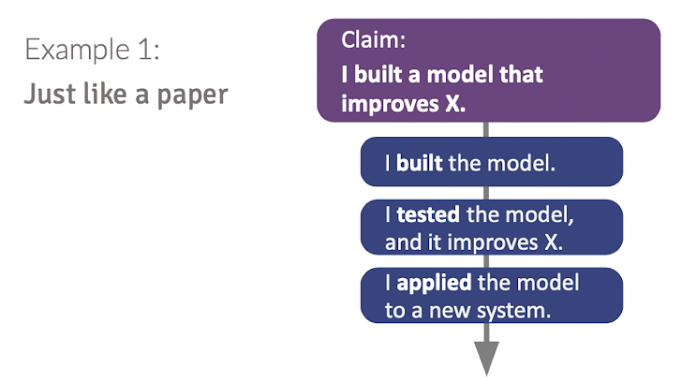
5.3. Connect the Evidence to Your Claims with Reasoning
One common mistake that students make when writing their thesis is treating each chapter as an isolated piece of writing. While it is helpful to break down the actual task of thesis writing into chapter-size pieces, these chapters should have some connection to one another. For your outline, it is ideal to identify what these connections were. Perhaps what made you start on one project was that you realized the weaknesses in your prior work and you wanted to make improvements. For readers who were not doing the research with you, describing the connections between your work in different chapters can help them understand the motivation and value of why you pursued each component.
5.4. Combine Your Claims, Evidence, and Reasoning to Produce Your Outline
Once you have identified your claims, the evidence you have surrounding each claim, and the reasoning that connects each piece of your work, you can now create your full outline, putting the pieces together like a jigsaw puzzle. An example outline is provided as an annotated example.
There are no requirements for minimum or maximum number of chapters that your master’s thesis can have. Therefore, when translating your outline to a literal chapter breakdown, you should feel free to use as many chapters as needed. If your methods section for a claim is extremely long, it may make more sense to have it be a standalone chapter, as shown in the attached annotated pdf.
6. Additional Resources
Every IAP, the Comm Lab hosts a workshop on how to write your master’s thesis. This workshop provides tips for writing each of these sections, and steps you through the process of creating an outline.
Resources and Annotated Examples
Example 1. structure diagram and table of contents, example 2. table of contents.
- How It Works
- PhD thesis writing
- Master thesis writing
- Bachelor thesis writing
- Dissertation writing service
- Dissertation abstract writing
- Thesis proposal writing
- Thesis editing service
- Thesis proofreading service
- Thesis formatting service
- Coursework writing service
- Research paper writing service
- Architecture thesis writing
- Computer science thesis writing
- Engineering thesis writing
- History thesis writing
- MBA thesis writing
- Nursing dissertation writing
- Psychology dissertation writing
- Sociology thesis writing
- Statistics dissertation writing
- Buy dissertation online
- Write my dissertation
- Cheap thesis
- Cheap dissertation
- Custom dissertation
- Dissertation help
- Pay for thesis
- Pay for dissertation
- Senior thesis
- Write my thesis
Writing a Top Thesis Outline – Your Comprehensive Guide

A thesis paper outline is a simple way of ensuring that each of your paragraphs serves a specific purpose in your paper. All students need to master this writing tool as it helps you organize your work.
What is a Thesis Outline?
A thesis outline is an organizational tool that writers use in their academic and professional thesis papers. Like a blueprint for your essay, it forms the foundation of the entire writing process. It is used to structure the main ideas into a list of easy and quick to follow contents.
Creating a thesis outline is vital in the following ways:
It gives a precise organization of the ideas Identifies parts of the paper that need special attention It singles out sections that need to be reduced or omitted Helps create connections and transitions where necessary It enables a student to fit the ideas systematically
Having a clearly defined thesis statement is better than a thousand thesis writers being dispatched at your disposal.
Thesis Outline Template
Now, what will make or break your master’s thesis outline or senior thesis outline is understanding its structure. It is not enough to have what to write but how to register it as well. That is why you need this template when writing a thesis outline.
Thesis Outline Format
A conventional thesis paper will have the following sections:
- Introduction (contains the background and thesis statement)
- The body paragraphs
- The conclusion
To attain this thesis structure’s best, you have to understand each part’s significance and how it contributes to the overall thesis paper. Let us look at how to write a thesis outline while delving deep into every section.
Thesis topic outline
A topic is described as the trigger button of your paper. It will determine whether your reader will have the interest to read your thesis or not. Therefore, when you are thinking about your thesis topic, consider the following:
- It should be brief and to the point (Do not explain or illustrate, just state)
- Use the keywords provided in the assignment for your topic
- AVOID using punctuations at the end
- It should be an eye-catcher and act as a bait
For you to have a good thesis topic, it should offer a solution. Nobody wants to spend his precious time on a paper that does not address a prevailing societal problem.
- How to do a thesis statement outline
The thesis statement is written in the introductory paragraph. Since this is the main idea for your paper, there is no room for error. Start with an attention-grabber that will lead the reader to your thesis statement.
Example of an attention grabber : Did you know that the average person who stays at home every day consumes over 10 tons of calories in a week?
Sample thesis statement : Excess calorie is a contributing factor to the high obesity rates patients witnessed in hospitals.
When creating a thesis statement outline, ensure that it relates to your introductory paragraph’s first two or three statements. Let it come out clearly so that the reader is prepared for what is coming next in the paper’s body.
They are made up of arguments in support of the thesis statement. This section carries a lot of weight as it either persuades or turns off the reader. Here is an outline for thesis paper body paragraphs:
Identify the main points Look for supporting ideas or evidence Have a list of transitional words from one section to another
The body of a thesis consists of the Literature Review, Research Methods, Results, and Discussion. It is recommended to begin with the literature review first before proceeding to the other two sections.
Since the Discussion is the longest part of the thesis, ensure that you gather all the necessary information needed to furnish it. In this part, you will need to identify the following aspects of your research process:
- Limitations of your study,
- Explanations for unexpected results, and
- Identify any questions that remain unanswered.
Every argument should be crystal clear to prevent any doubt or object on the part of the reader.
- The Conclusion
Though it appears last, it is one of the most critical sections of your thesis. It is the chapter that shows whether you achieved your research objectives or not. In this part, you can point out the following:
Point out the challenges you encountered in your study Your lessons from the research Make recommendations for future research
The conclusion should be a point where you identify whether every hypothesis was met or objective was achieved. It is vital to note that this chapter should short and clear to the end. Now that you have argued your case make this as your final nail to the coffin.
How To Make a Thesis Outline – Step By Step Guide
A superb outline can ease your research process and make your thesis writing process quick and easy. When you are thinking of creating a thesis paper outline, consider the following steps:
Read and understand the question first. If your tutor has given you a topic or question for your thesis, ensure that you digest it well to understand what is required of you. It will help to align your thesis outline correctly. Check for similar thesis outlines on the same topic. You can Google for any reliable thesis outline example that is similar to your topic of research. By doing this, you will get a rough idea of what is expected of you. Consult with your professor on the thesis outline format for your institution. Different institutions have varying structures, and thus, you need to use one that matches your institution’s house style. Do not rush into creating the outline. Before you draft your strategy, ensure that you have all the essentials at your fingertips first. Since this will be your guiding principle, it should be devoid of any errors or bogus steps.
After setting your house in order, writing your thesis paper is now time for the real task.
If you did not know how to create a thesis outline, we hope that this writing guide has served that purpose for you. Nevertheless, we also have a thesis writing service that offers students with online assistance.
Get help with thesis outline at affordable rates today. You can also find a master thesis outline example from gurus who have been in this business for decades. What is holding you now?

Leave a Reply Cancel reply
Your email address will not be published. Required fields are marked *
Comment * Error message
Name * Error message
Email * Error message
Save my name, email, and website in this browser for the next time I comment.
As Putin continues killing civilians, bombing kindergartens, and threatening WWIII, Ukraine fights for the world's peaceful future.
Ukraine Live Updates

Butte College Library
- Books & More
- e-Book Collections
- e-Journal Titles
- Web Resources
- Other Libraries
- How do I...?
- Tipsheets & Guides
- Instruction Videos
- Research Papers
- Information Literacy
- Library Classes
- My Library Account
- Borrowing Books
- Renew Books
- Place a Hold
- Interlibrary Loan
- Library Instruction
- Test Proctoring
- Place Items on Reserve
- For Faculty
- Search Reserves
- For Students
- About the Library
- Dean's Page
- News & Events
- Areas of Service
- Study Rooms
- Chico Center
- Main Campus
- Library Values
- Code of Conduct
- Circulation
- Computer Use
- Collection Development
- Service Desks
- Staff Directory
- Ask Us
- Recommend a Purchase
- Comments & Suggestions
Research Paper Menu
- 1. Overview
- 2. Finding Topic Ideas
3. Creating a Thesis Statement & Outline
- 4. Choosing Appropriate Resources
- 5. Using Butte College Library Resources
- 6. Scholarly Journals
- 7. Online Search Techniques
- 8. Taking Notes and Documenting Sources
- 9. Evaluation of Resources
- 10. Citation and Plagiarism
I.What is a thesis statement?
A thesis statement is usually a sentence that states your argument to the reader. It usually appears in the first paragraph of an essay.
II. Why do I need to write a thesis statement for a paper?
Your thesis statement states what you will discuss in your essay. Not only does it define the scope and focus of your essay, it also tells your reader what to expect from the essay.
A thesis statement can be very helpful in constructing the outline of your essay.
Also, your instructor may require a thesis statement for your paper.
III. How do I create a thesis statement?
A thesis statement is not a statement of fact. It is an assertive statement that states your claims and that you can prove with evidence. It should be the product of research and your own critical thinking. There are different ways and different approaches to write a thesis statement. Here are some steps you can try to create a thesis statement:
1. Start out with the main topic and focus of your essay.
Example: youth gangs + prevention and intervention programs
2. Make a claim or argument in one sentence.
Example: Prevention and intervention programs can stop youth gang activities.
3. Revise the sentence by using specific terms.
Example: Early prevention programs in schools are the most effective way to prevent youth gang involvement.
4. Further revise the sentence to cover the scope of your essay and make a strong statement.
Example: Among various prevention and intervention efforts that have been made to deal with the rapid growth of youth gangs, early school-based prevention programs are the most effective way to prevent youth gang involvement.
IV. Can I revise the thesis statement in the writing process?
Sure. In fact, you should keep the thesis statement flexible and revise it as needed. In the process of researching and writing, you may find new information that falls outside the scope of your original plan and want to incorporate it into your paper. Or you probably understand your thoughts more and shift the focus of your paper. Then you will need to revise your thesis statement while you are writing the paper.
V. Why do I need to make an outline when I already have a thesis statement?
An outline is the "road map" of your essay in which you list the arguments and subtopics in a logical order. A good outline is an important element in writing a good paper. An outline helps to target your research areas, keep you within the scope without going off-track, and it can also help to keep your argument in good order when writing the essay.
VI. How do I make an outline?
You list all the major topics and subtopics with key points that support them. Put similar topics and points together and arrange them in a logical order.
Include an Introduction , a Body , and a Conclusion in your outline. You can make an outline in a list format or a chart format .
Next Chapter: 4. Choosing Appropriate Resources
Reference management. Clean and simple.
Getting started with your research paper outline

Levels of organization for a research paper outline
First level of organization, second level of organization, third level of organization, fourth level of organization, tips for writing a research paper outline, research paper outline template, my research paper outline is complete: what are the next steps, frequently asked questions about a research paper outline, related articles.
The outline is the skeleton of your research paper. Simply start by writing down your thesis and the main ideas you wish to present. This will likely change as your research progresses; therefore, do not worry about being too specific in the early stages of writing your outline.
A research paper outline typically contains between two and four layers of organization. The first two layers are the most generalized. Each layer thereafter will contain the research you complete and presents more and more detailed information.
The levels are typically represented by a combination of Roman numerals, Arabic numerals, uppercase letters, lowercase letters but may include other symbols. Refer to the guidelines provided by your institution, as formatting is not universal and differs between universities, fields, and subjects. If you are writing the outline for yourself, you may choose any combination you prefer.
This is the most generalized level of information. Begin by numbering the introduction, each idea you will present, and the conclusion. The main ideas contain the bulk of your research paper 's information. Depending on your research, it may be chapters of a book for a literature review , a series of dates for a historical research paper, or the methods and results of a scientific paper.
I. Introduction
II. Main idea
III. Main idea
IV. Main idea
V. Conclusion
The second level consists of topics which support the introduction, main ideas, and the conclusion. Each main idea should have at least two supporting topics listed in the outline.
If your main idea does not have enough support, you should consider presenting another main idea in its place. This is where you should stop outlining if this is your first draft. Continue your research before adding to the next levels of organization.
- A. Background information
- B. Hypothesis or thesis
- A. Supporting topic
- B. Supporting topic
The third level of organization contains supporting information for the topics previously listed. By now, you should have completed enough research to add support for your ideas.
The Introduction and Main Ideas may contain information you discovered about the author, timeframe, or contents of a book for a literature review; the historical events leading up to the research topic for a historical research paper, or an explanation of the problem a scientific research paper intends to address.
- 1. Relevant history
- 2. Relevant history
- 1. The hypothesis or thesis clearly stated
- 1. A brief description of supporting information
- 2. A brief description of supporting information
The fourth level of organization contains the most detailed information such as quotes, references, observations, or specific data needed to support the main idea. It is not typical to have further levels of organization because the information contained here is the most specific.
- a) Quotes or references to another piece of literature
- b) Quotes or references to another piece of literature
Tip: The key to creating a useful outline is to be consistent in your headings, organization, and levels of specificity.
- Be Consistent : ensure every heading has a similar tone. State the topic or write short sentences for each heading but avoid doing both.
- Organize Information : Higher levels of organization are more generally stated and each supporting level becomes more specific. The introduction and conclusion will never be lower than the first level of organization.
- Build Support : Each main idea should have two or more supporting topics. If your research does not have enough information to support the main idea you are presenting, you should, in general, complete additional research or revise the outline.
By now, you should know the basic requirements to create an outline for your paper. With a content framework in place, you can now start writing your paper . To help you start right away, you can use one of our templates and adjust it to suit your needs.
After completing your outline, you should:
- Title your research paper . This is an iterative process and may change when you delve deeper into the topic.
- Begin writing your research paper draft . Continue researching to further build your outline and provide more information to support your hypothesis or thesis.
- Format your draft appropriately . MLA 8 and APA 7 formats have differences between their bibliography page, in-text citations, line spacing, and title.
- Finalize your citations and bibliography . Use a reference manager like Paperpile to organize and cite your research.
- Write the abstract, if required . An abstract will briefly state the information contained within the paper, results of the research, and the conclusion.
An outline is used to organize written ideas about a topic into a logical order. Outlines help us organize major topics, subtopics, and supporting details. Researchers benefit greatly from outlines while writing by addressing which topic to cover in what order.
The most basic outline format consists of: an introduction, a minimum of three topic paragraphs, and a conclusion.
You should make an outline before starting to write your research paper. This will help you organize the main ideas and arguments you want to present in your topic.
- Consistency: ensure every heading has a similar tone. State the topic or write short sentences for each heading but avoid doing both.
- Organization : Higher levels of organization are more generally stated and each supporting level becomes more specific. The introduction and conclusion will never be lower than the first level of organization.
- Support : Each main idea should have two or more supporting topics. If your research does not have enough information to support the main idea you are presenting, you should, in general, complete additional research or revise the outline.

Purdue Online Writing Lab Purdue OWL® College of Liberal Arts
Tips and Examples for Writing Thesis Statements

Welcome to the Purdue OWL
This page is brought to you by the OWL at Purdue University. When printing this page, you must include the entire legal notice.
Copyright ©1995-2018 by The Writing Lab & The OWL at Purdue and Purdue University. All rights reserved. This material may not be published, reproduced, broadcast, rewritten, or redistributed without permission. Use of this site constitutes acceptance of our terms and conditions of fair use.
Tips for Writing Your Thesis Statement
1. Determine what kind of paper you are writing:
- An analytical paper breaks down an issue or an idea into its component parts, evaluates the issue or idea, and presents this breakdown and evaluation to the audience.
- An expository (explanatory) paper explains something to the audience.
- An argumentative paper makes a claim about a topic and justifies this claim with specific evidence. The claim could be an opinion, a policy proposal, an evaluation, a cause-and-effect statement, or an interpretation. The goal of the argumentative paper is to convince the audience that the claim is true based on the evidence provided.
If you are writing a text that does not fall under these three categories (e.g., a narrative), a thesis statement somewhere in the first paragraph could still be helpful to your reader.
2. Your thesis statement should be specific—it should cover only what you will discuss in your paper and should be supported with specific evidence.
3. The thesis statement usually appears at the end of the first paragraph of a paper.
4. Your topic may change as you write, so you may need to revise your thesis statement to reflect exactly what you have discussed in the paper.
Thesis Statement Examples
Example of an analytical thesis statement:
The paper that follows should:
- Explain the analysis of the college admission process
- Explain the challenge facing admissions counselors
Example of an expository (explanatory) thesis statement:
- Explain how students spend their time studying, attending class, and socializing with peers
Example of an argumentative thesis statement:
- Present an argument and give evidence to support the claim that students should pursue community projects before entering college
Academic Editing and Proofreading
- What is Predatory Publishing?
- Tips to Self-Edit Your Dissertation
- Guide to Essay Editing: Methods, Tips, & Examples
- Journal Article Proofreading: Process, Cost, & Checklist
- The A–Z of Dissertation Editing: Standard Rates & Involved Steps
- Research Paper Editing | Guide to a Perfect Research Paper
- Dissertation Proofreading | Definition & Standard Rates
- Thesis Proofreading | Definition, Importance & Standard Pricing
- Research Paper Proofreading | Definition, Significance & Standard Rates
- Essay Proofreading | Options, Cost & Checklist
- Top 10 Essay Editing Services of 2023
Academic Research
- Research Paper Outline: Templates & Examples
- How to Write a Lab Report: Examples from Academic Editors
Academic Writing & Publishing
- Difference Between Paper Editing and Peer Review
- What are the different types of peer review?
- How to deal with rejection from a journal?
- Editing and Proofreading Academic Papers: A Short Guide
- Primary and Secondary Sources
- How to Carry Out Secondary Research
- The Results Section of a Dissertation
- Checklist: Is my Article Ready for Submitting to Journals?
- Types of Research Articles to Boost Your Research Profile
- The Top 5 Dos & Don’ts of Academic Writing | Useful Examples
- 8 Types of Peer Review Processes You Should Know
- The Ethics of Academic Research
- How to Create In-Text Citations and Reference Page in APA 7
- MLA 9th Edition Paper Format Guidelines
- How To Craft Winning Admission Essays
- How does LaTeX based proofreading work?
- How to Improve Your Scientific Writing: A Short Guide
- Chicago Title, Cover Page & Body | Paper Format Guidelines
- How to Write a Thesis Statement: Examples & Tips
- Chicago Style Citation: Quick Guide & Examples
- Top 10 Dissertation Editing Services of 2023
- How to Format a College Essay: Format Template & Tips
- APA Header, Cover Page & Body – Paper Format Guidelines
- The A-Z Of Publishing Your Article in A Journal
- What is Journal Article Editing? 3 Reasons You Need It
- 5 Powerful Personal Statement Examples (Template Included)
- Additional Resources
- Formatting Tips on MS Word for Dissertations
- Plagiarism: How to avoid it in your thesis?
- Final Submission Checklist | Dissertation & Thesis
- 7 Useful MS Word formatting tips for dissertation writing
- How to Write a MEAL Paragraph: Writing Plan Explained in Detail
- Top 10 Free Citation Generators in 2023 | Quick & Easy
- Citation and Referencing
- Citing References: APA, MLA, and Chicago
- Why is it Important to Cite Your Sources?
- How to Cite Sources in the MLA Format
- MLA Citation Examples: Cite Essays, Websites, Movies & More
- APA Citation Examples: The Bible, TED Talk, PPT & More
- 10 Best Free Plagiarism Checkers of 2023 [100% Free Tools]
- Citations and References: What Are They and Why They Matter
- Dissertation Writing Guide
- Writing a Dissertation Proposal
- Top 10 Best Academic Research Resources
- How to Prepare for Your Dissertation Defense
- The Acknowledgments Section of a Dissertation
- Abstract: An Introduction
- The Table of Contents Page of a Dissertation
- The Introduction Chapter of a Dissertation
- The Literature Review of a Dissertation
- How to Choose a Topic for Your Dissertation
- The Only Dissertation Toolkit You’ll Ever Need!
- 5 Thesis Writing Tips for Master Procrastinators
- How to Write a Dissertation | 5 Tips from Academic Editors
- The Title Page of a Dissertation
- The 5 Things to Look for in a Dissertation Editing Service
- Top 10 Dissertation Editing & Proofreading Services
- Why is it important to add references to your thesis?
- The Research Methodology Section of a Dissertation
- Thesis Editing | Definition, Scope & Standard Rates
- Essay Writing Guide
- How to Pick the Perfect Essay Topic
- Essential Research Tips for Essay Writing
- Top 10 Essay Writing Tools in 2023 | Plan, Write, Get Feedback
- How to Write an Impactful Personal Statement (Examples Included)
- What Is a Mind Map? Free Mind Map Templates & Examples
- How to Structure Your Essay
How to Write an Essay Outline: 5 Examples & Free Template
- How to Write an Essay Header: MLA and APA Essay Headers
- What Is an Essay? Structure, Parts, and Types
- How to Write an Essay in 8 Simple Steps (Examples Included)
- 8 Types of Essays | Quick Summary with Examples
- Expository Essays | Step-by-Step Manual with Examples
- Narrative Essay | Step-by-Step Guide with Examples
- How to Write an Argumentative Essay (Examples Included)
- Guide to a Perfect Descriptive Essay [Examples & Outline Included]
- How to Start an Essay: 4 Introduction Paragraph Examples
- How to Write a Conclusion for an Essay (Examples Included!)
- Test Post for HTML Codes
Still have questions? Leave a comment
Add Comment

Checklist: Dissertation Proposal
Enter your email id to get the downloadable right in your inbox!

Examples: Edited Papers
Need editing and proofreading services.

abcdefghijlk

Editing & Proofreading for Authors
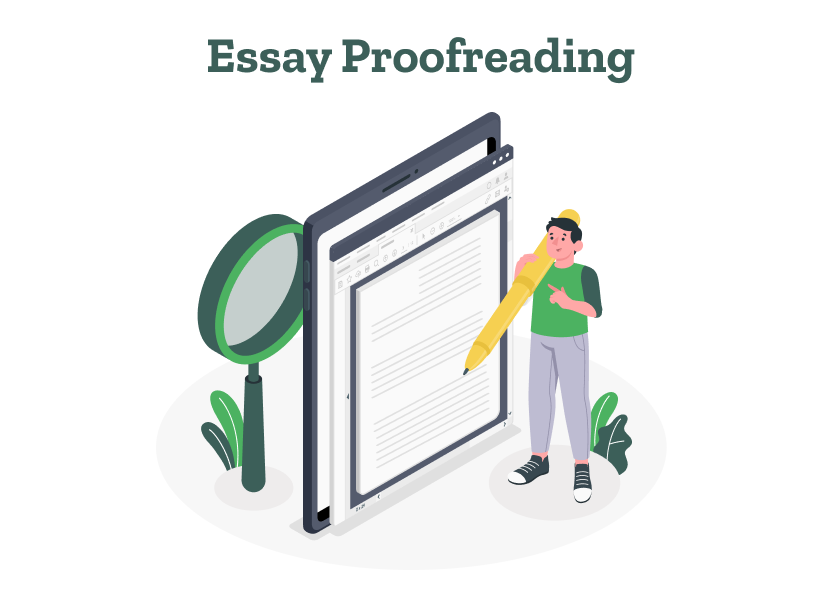
- Tags: Academic Writing , Essay
Creating a clear and organized essay is not easy, but making an outline can help. By arranging your ideas in a logical and coherent way, an essay outline can guide you in effectively structuring your essay.
Whether you’re working on a school or college assignment, take the time to create an outline. It can help you overcome the challenges of organizing your thoughts while writing. In this article, we’ll take a look at how to create an essay outline with the help of some useful examples and a downloadable template.
What is an essay outline?
An outline acts as a blueprint for your essay, presenting the structure and content of each paragraph and showing how they connect. By creating an outline, you can streamline the writing process and minimize the need for revisions. It can also help you develop strong points to support your thesis statement .
Typically, an outline is created after establishing a working thesis statement and gathering relevant information. The collected information is then organized into a logical flow that can be expanded into a structured essay.
Why is it important to create an essay outline?
An essay outline not only gives structure to your essay but also helps effectively link its parts. It helps create a logical flow for your essay and also helps identify its primary components. Let’s take a look at this in detail.
1. Sets a logical order
To create a well-structured and impactful essay, the arrangement of information is key. Creating an essay outline makes it easier to organize bits of information from general to specific.
Start off by creating a broad thesis statement or central idea. Then move on to providing examples or pieces of information that support this statement or elaborate on it. This method also provides a comprehensive overview of your essay and helps identify any missing bits of information.
2. Generates greater impact
The primary goal of your essay is to effectively present information that supports your thesis statement. If your essay is haphazardly structured, the message of the thesis statement can get lost.
In order to present a coherent message, determine the important bits of information that best support your thesis statement and organize them logically. Then elaborate on these bits to create a flow. This not only creates a greater impact but also makes your final essay more convincing.
3. Leads to smoother transitions
Transitions are the bridges that connect your ideas and ensure that your argument flows smoothly. However, creating smooth transitions from one point to another can be quite challenging.
A college essay outline helps you identify where you need to include transitions and what type of transition you should use to connect your ideas effectively. Creating smooth, logical, and cohesive transitions is crucial in ensuring that readers can easily follow your train of thought and grasp your argument.
How to write an essay outline
After conducting all the necessary research, it is time to narrow down the central idea of your essay. Make sure that the scope of your idea is neither too broad nor too narrow.
Select the main bits of information that elaborate on this central idea and organize them in a logical manner. Then provide specific examples to back them up. Let’s take a detailed look at these steps.
1. Figure out the central message or the thesis statement of your essay.
Picking out a central idea or generic point for your essay can help create a base you can elaborate upon.
You can start with a broad idea or stance and then research the specific bits of information that support this idea and provide more information on it.
2. Identify the main points or arguments.
After collecting the necessary information to elaborate on your central idea, identify the broad points that give it substance.
These points will form the headings of the essay. They should be broad enough to cover major themes, but specific enough to provide a clear focus for each section.
3. Organize your headings.
Decide the logical flow of your essay and arrange your headings in an organized manner.
It is crucial to have obvious starting and ending points, but the body can be organized in a way you consider to be the most impactful. Depending on the type of essay, your headings can be arranged chronologically, on the basis of importance, or from general to specific.
4. Provide examples and evidence to support the headings.
Once the headings are created and organized, provide statistics, anecdotes, and examples to back them up. These specific pieces of information can be elaborated upon while writing your first draft.
You can use this general essay outline format to create your own
Essay outline template
To help you write a logical, well-structured, impactful essay, we have developed this fool-proof, comprehensive essay outline template. It will help you categorize all your essential information into well-structured, organized headings and subheadings.
The template includes an introduction, three body paragraphs, an optional paragraph for a counter-argument, and a conclusion. Under each of these headings, there are relevant subheadings that are applicable to all types of essays.
The template uses an alphanumeric format, with Roman numerals for the headings and capital letters for the subheadings.
Download Free Outline Essay Template
Essay outline examples .
Essays are highly versatile pieces of writing. They include various types, such as persuasive essays, compare and contrast essays, analytical essays, and cause-and-effect essays.
But most of these essay types are a combination or a derivation of these four main types of essays. They include narrative, descriptive, argumentative, and expository essays.
Each of these essays serves a different purpose and is structured differently. Let’s understand the purpose of each of these essay types with the help of relevant essay outline examples:

1. Narrative essay outline
A narrative essay outline is a highly personalized outline that reflects your unique experiences, feelings, and observations.
The goal of this outline is to tell an impactful story with the help of vivid descriptions and sensory details that engage the reader’s attention.
Narrative essay outline example
Let us better understand the narrative essay outline with the help of an example. The following example is a personal narrative about growing up as an immigrant child.
I. Introduction
A. A vivid description of the moment I found out I was moving to a new country.
B. Brief explanation of my background and reasons for immigrating.
C. Thesis statement: The challenges and opportunities I faced as an immigrant in a new country.
A. Struggles in adjusting to a new culture.
1. Language barriers I faced in school and everyday life.
2. Differences in cultural norms and expectations.
B. Navigating a new education system
1. Differences in teaching styles and expectations.
2. Adjusting to a new curriculum and grading system.
C. Finding a sense of belonging
1. Challenges in making friends and building relationships.
2. Coping with homesickness and missing family and friends.
III. Conclusion
A. Reflection on my journey as an immigrant
1. Lessons learned and personal growth.
2. Significance of the experience.
B. Acknowledgment of my resilience and determination.
1. Overcoming challenges and achieving success.
2. Encouragement for others facing similar challenges.
C. Memorable closing statement related to my journey.
2. Argumentative essay outline
An argumentative essay outline requires you to take a clear stance on a topic and provide strong evidence to support it.
The goal of this outline is to convince the reader to see your point of view on a controversial topic.
Argumentative essay outline example
The following example shows us how the internet is beneficial to the mental development of school children. It establishes the internet to be a valuable resource for children.
A. A surprising statistic or fact about children and their use of the internet.
B. Brief explanation of the prevalence of the internet in modern society and its impact on children.
C. Thesis statement: Despite concerns about safety and privacy, the internet is a valuable resource for children due to its educational opportunities, communication tools, and access to diverse perspectives.
A. Education opportunities.
1. Access to information and resources that may not be available in traditional classroom settings.
2. Interactive tools and games that can reinforce learning and engage children in new ways.
B. Communication tools
1. Social media and messaging platforms that allow children to connect with peers and mentors.
2. Online forums and discussion groups that foster collaboration and problem-solving skills.
C. Exposure to diverse perspectives
1. Access to a variety of viewpoints and perspectives from around the world.
2. Exposure to different cultures and ways of thinking can foster empathy and understanding.
III. Counterarguments and Rebuttal
A. Potential safety concerns and risks associated with internet use
1. Explanation of safety measures and precautions that can mitigate these risks.
2. Rebuttal of the idea that the risks outweigh the benefits.
B. Potential negative effects on cognitive and social development
1. Explanation of the positive effects of internet use on cognitive development and social skills.
2. Rebuttal of the idea that the internet is inherently harmful to children.
IV. Conclusion
A. Restatement of thesis statement and main points of the argument.
B. Reflection on the importance of the internet as a valuable resource for children.
C. Final thoughts and call to action for readers to embrace the benefits of internet use for children.
3. Expository essay outline
An expository essay outline requires you to provide a detailed overview of a subject from all angles. It is used to test your knowledge of a particular subject.
The purpose of this essay outline is to inform, explain, or describe a topic or idea, rather than to persuade the reader or share personal opinions.
This type of essay is often used in academic settings, such as in writing assignments, research papers, or even textbooks.
Expository essay outline example
The following example provides us with information on SONAR technology, its uses, its impact on the environment, as well as its benefits.
A. A brief explanation of the significance of SONAR and its impact on underwater navigation and detection.
B. A definition of SONAR and its origins, and the history of its development and uses.
C. Thesis statement: This essay will provide a detailed overview of the use of SONAR technology, its applications, and its impact on various fields.
A. Explanation of SONAR technology
- Basic principles of SONAR.
- Types of SONAR and how they work.
B. Applications of SONAR technology
1. Military applications, including submarine detection and mine detection.
2. Commercial applications, including underwater mapping and exploration, and marine life observation.
C. Advantages and disadvantages of SONAR technology
1. Advantages, such as accuracy and range.
2. Disadvantages, such as interference and environmental impact.
A. Safety and environmental concerns
1. Explanation of the measures taken to minimize the environmental impact of SONAR technology.
2. Rebuttal of the idea that the benefits of SONAR technology are outweighed by its environmental impact.
B. Potential misuse or abuse of SONAR technology
1. Explanation of regulations and laws governing the use of SONAR technology.
2. Rebuttal of the idea that the potential misuse of SONAR technology justifies limiting its applications.
B. Reflection on the significance of SONAR technology and its impact on various fields.
C. Final thoughts and call to action for readers to learn more about SONAR technology and its applications.
4. Descriptive essay outline
A descriptive essay outline requires you to create a detailed and sensory-rich description of a person, place, object, event, or experience.
The goal is to provide the reader with a visceral experience that engages their senses and imagination.
Descriptive essay outline example
The following example provides a highly immersive experience and uses multiple sensory descriptors to describe the summers spent by the writer at their grandmother’s farm.
A. Description of a typical summer day at grandma’s farm.
B. Brief overview of the location and purpose of the farm.
C. Thesis statement: Summers spent at grandma’s farm were some of the most memorable and enjoyable times of my childhood, thanks to the idyllic setting and the rich sensory experiences it provided.
II. Body Paragraph 1: The Scenery
A. Topic sentence: The farm was located in a picturesque rural area surrounded by rolling hills and green pastures.
B. Sensory details:
1. Visual: Describe the lush greenery, the colorful flowers, and the endless expanse of blue sky.
2. Auditory: Mention the sound of the chirping birds, the rustling leaves, and the occasional mooing of cows.
3. Olfactory: Describe the fragrant smell of fresh hay and the earthy aroma of the soil.
4. Tactile: Describe the feeling of the warm sun on the skin and the softness of the grass underfoot.
III. Body Paragraph 2: The Activities
A. Topic sentence: The farm provided numerous activities and tasks that kept me busy and engaged throughout the day.
1. Visual: Describe the sight of the cows grazing, the chickens clucking, and the horses trotting.
2. Auditory: Mention the sound of the milking machine, the creaking of the barn doors, and the whinnying of the horses.
3. Olfactory: Describe the smell of the freshly baked pies, the wood smoke from the bonfire, and the scent of the freshly cut grass.
4. Tactile: Describe the feeling of the cow’s rough tongue licking my hand, the warmth of the freshly laid eggs, and the rough texture of the hay bales.
IV. Body Paragraph 3: The People
A. Topic sentence: The farm was a family affair, and spending time with my grandmother and other relatives was a highlight of the summer.
1. Visual: Describe the sight of my grandmother cooking in the kitchen, my cousins running through the fields, and my uncles fixing machinery.
2. Auditory: Mention the sound of laughter and conversation around the dinner table, the chatter of family members working together, and the clinking of dishes.
3. Olfactory: Describe the smell of home-cooked meals, the familiar scents of family members, and the aroma of freshly brewed coffee.
4. Tactile: Describe the feeling of hugs from family members, the rough texture of my grandfather’s hand, and the warmth of a family embrace.
V. Conclusion
A. Restate thesis: Summers spent at grandma’s farm were truly unforgettable, filled with vivid sensory experiences and cherished memories.
B. Summarize main points: Recap the main sensory details and experiences shared in the essay.
C. Final thoughts: Reflect on the impact of the farm on the writer’s life and express gratitude for the memories made there.
Here are some related articles that you might find interesting:
- How to Write an Essay in 8 Simple Steps
Frequently Asked Questions
What is an outline for an essay, what is the one important rule of essay outlining, what are the four main components to keep in mind while constructing an essay outline, what are the basic principles of essay outlining, what is the purpose of an outline.
Found this article helpful?

Leave a Comment: Cancel reply
Your email address will not be published.

Your Organization Needs a Technical Editor: Here’s Why

Writing for the Web: How Your Readers Want to Read Content

Writing Contests 2023: Cash Prizes, Free Entries, & More!.

Writing Content to Achieve a Higher Readability
Subscribe to our Newsletter
How to Copyright Your Book?
If you’ve thought about copyrighting your book, you’re on the right path.
© 2024 All rights reserved
- Terms of service
- Privacy policy
- Self Publishing Guide
- Pre-Publishing Steps
- Fiction Writing Tips
- Traditional Publishing
- Academic Writing and Publishing
- Partner with us
- Annual report
- Website content
- Marketing material
- Job Applicant
- Cover letter
- Case studies
What’s Included: The Dissertation Template
If you’re preparing to write your dissertation, thesis or research project, our free dissertation template is the perfect starting point. In the template, we cover every section step by step, with clear, straightforward explanations and examples .
The template’s structure is based on the tried and trusted best-practice format for formal academic research projects such as dissertations and theses. The template structure reflects the overall research process, ensuring your dissertation or thesis will have a smooth, logical flow from chapter to chapter.
The dissertation template covers the following core sections:
- The title page/cover page
- Abstract (sometimes also called the executive summary)
- Table of contents
- List of figures /list of tables
- Chapter 1: Introduction (also available: in-depth introduction template )
- Chapter 2: Literature review (also available: in-depth LR template )
- Chapter 3: Methodology (also available: in-depth methodology template )
- Chapter 4: Research findings /results (also available: results template )
- Chapter 5: Discussion /analysis of findings (also available: discussion template )
- Chapter 6: Conclusion (also available: in-depth conclusion template )
- Reference list
Each section is explained in plain, straightforward language , followed by an overview of the key elements that you need to cover within each section. We’ve also included practical examples to help you understand exactly what’s required in each section.
The cleanly-formatted Google Doc can be downloaded as a fully editable MS Word Document (DOCX format), so you can use it as-is or convert it to LaTeX.
FAQs: Dissertation Template
What format is the template (doc, pdf, ppt, etc.).
The dissertation template is provided as a Google Doc. You can download it in MS Word format or make a copy to your Google Drive. You’re also welcome to convert it to whatever format works best for you, such as LaTeX or PDF.
What types of dissertations/theses can this template be used for?
The template follows the standard best-practice structure for formal academic research projects such as dissertations or theses, so it is suitable for the vast majority of degrees, particularly those within the sciences.
Some universities may have some additional requirements, but these are typically minor, with the core structure remaining the same. Therefore, it’s always a good idea to double-check your university’s requirements before you finalise your structure.
Will this work for a research paper?
A research paper follows a similar format, but there are a few differences. You can find our research paper template here .
Is this template for an undergrad, Masters or PhD-level thesis?
This template can be used for a dissertation, thesis or research project at any level of study. It may be slight overkill for an undergraduate-level study, but it certainly won’t be missing anything.
How long should my dissertation/thesis be?
This depends entirely on your university’s specific requirements, so it’s best to check with them. As a general ballpark, Masters-level projects are usually 15,000 – 20,000 words in length, while Doctoral-level projects are often in excess of 60,000 words.
What about the research proposal?
If you’re still working on your research proposal, we’ve got a template for that here .
We’ve also got loads of proposal-related guides and videos over on the Grad Coach blog .
How do I write a literature review?
We have a wealth of free resources on the Grad Coach Blog that unpack how to write a literature review from scratch. You can check out the literature review section of the blog here.
How do I create a research methodology?
We have a wealth of free resources on the Grad Coach Blog that unpack research methodology, both qualitative and quantitative. You can check out the methodology section of the blog here.
Can I share this dissertation template with my friends/colleagues?
Yes, you’re welcome to share this template. If you want to post about it on your blog or social media, all we ask is that you reference this page as your source.
Can Grad Coach help me with my dissertation/thesis?
Within the template, you’ll find plain-language explanations of each section, which should give you a fair amount of guidance. However, you’re also welcome to consider our dissertation and thesis coaching services .

- Translators
- Graphic Designers
Please enter the email address you used for your account. Your sign in information will be sent to your email address after it has been verified.
25 Thesis Statement Examples That Will Make Writing a Breeze

Understanding what makes a good thesis statement is one of the major keys to writing a great research paper or argumentative essay. The thesis statement is where you make a claim that will guide you through your entire paper. If you find yourself struggling to make sense of your paper or your topic, then it's likely due to a weak thesis statement.
Let's take a minute to first understand what makes a solid thesis statement, and what key components you need to write one of your own.

A thesis statement always goes at the beginning of the paper. It will typically be in the first couple of paragraphs of the paper so that it can introduce the body paragraphs, which are the supporting evidence for your thesis statement.
Your thesis statement should clearly identify an argument. You need to have a statement that is not only easy to understand, but one that is debatable. What that means is that you can't just put any statement of fact and have it be your thesis. For example, everyone knows that puppies are cute . An ineffective thesis statement would be, "Puppies are adorable and everyone knows it." This isn't really something that's a debatable topic.
Something that would be more debatable would be, "A puppy's cuteness is derived from its floppy ears, small body, and playfulness." These are three things that can be debated on. Some people might think that the cutest thing about puppies is the fact that they follow you around or that they're really soft and fuzzy.
All cuteness aside, you want to make sure that your thesis statement is not only debatable, but that it also actually thoroughly answers the research question that was posed. You always want to make sure that your evidence is supporting a claim that you made (and not the other way around). This is why it's crucial to read and research about a topic first and come to a conclusion later. If you try to get your research to fit your thesis statement, then it may not work out as neatly as you think. As you learn more, you discover more (and the outcome may not be what you originally thought).
Additionally, your thesis statement shouldn't be too big or too grand. It'll be hard to cover everything in a thesis statement like, "The federal government should act now on climate change." The topic is just too large to actually say something new and meaningful. Instead, a more effective thesis statement might be, "Local governments can combat climate change by providing citizens with larger recycling bins and offering local classes about composting and conservation." This is easier to work with because it's a smaller idea, but you can also discuss the overall topic that you might be interested in, which is climate change.
So, now that we know what makes a good, solid thesis statement, you can start to write your own. If you find that you're getting stuck or you are the type of person who needs to look at examples before you start something, then check out our list of thesis statement examples below.
Thesis statement examples
A quick note that these thesis statements have not been fully researched. These are merely examples to show you what a thesis statement might look like and how you can implement your own ideas into one that you think of independently. As such, you should not use these thesis statements for your own research paper purposes. They are meant to be used as examples only.
- Vaccinations Because many children are unable to vaccinate due to illness, we must require that all healthy and able children be vaccinated in order to have herd immunity.
- Educational Resources for Low-Income Students Schools should provide educational resources for low-income students during the summers so that they don't forget what they've learned throughout the school year.
- School Uniforms School uniforms may be an upfront cost for families, but they eradicate the visual differences in income between students and provide a more egalitarian atmosphere at school.
- Populism The rise in populism on the 2016 political stage was in reaction to increasing globalization, the decline of manufacturing jobs, and the Syrian refugee crisis.
- Public Libraries Libraries are essential resources for communities and should be funded more heavily by local municipalities.
- Cyber Bullying With more and more teens using smartphones and social media, cyber bullying is on the rise. Cyber bullying puts a lot of stress on many teens, and can cause depression, anxiety, and even suicidal thoughts. Parents should limit the usage of smart phones, monitor their children's online activity, and report any cyber bullying to school officials in order to combat this problem.
- Medical Marijuana for Veterans Studies have shown that the use of medicinal marijuana has been helpful to veterans who suffer from Post-Traumatic Stress Disorder (PTSD). Medicinal marijuana prescriptions should be legal in all states and provided to these veterans. Additional medical or therapy services should also be researched and implemented in order to help them re-integrate back into civilian life.
- Work-Life Balance Corporations should provide more work from home opportunities and six-hour workdays so that office workers have a better work-life balance and are more likely to be productive when they are in the office.
- Teaching Youths about Consensual Sex Although sex education that includes a discussion of consensual sex would likely lead to less sexual assault, parents need to teach their children the meaning of consent from a young age with age appropriate lessons.
- Whether or Not to Attend University A degree from a university provides invaluable lessons on life and a future career, but not every high school student should be encouraged to attend a university directly after graduation. Some students may benefit from a trade school or a "gap year" where they can think more intensely about what it is they want to do for a career and how they can accomplish this.
- Studying Abroad Studying abroad is one of the most culturally valuable experiences you can have in college. It is the only way to get completely immersed in another language and learn how other cultures and countries are different from your own.
- Women's Body Image Magazines have done a lot in the last five years to include a more diverse group of models, but there is still a long way to go to promote a healthy woman's body image collectively as a culture.
- Cigarette Tax Heavily taxing and increasing the price of cigarettes is essentially a tax on the poorest Americans, and it doesn't deter them from purchasing. Instead, the state and federal governments should target those economically disenfranchised with early education about the dangers of smoking.
- Veganism A vegan diet, while a healthy and ethical way to consume food, indicates a position of privilege. It also limits you to other cultural food experiences if you travel around the world.
- University Athletes Should be Compensated University athletes should be compensated for their service to the university, as it is difficult for these students to procure and hold a job with busy academic and athletic schedules. Many student athletes on scholarship also come from low-income neighborhoods and it is a struggle to make ends meet when they are participating in athletics.
- Women in the Workforce Sheryl Sandberg makes a lot of interesting points in her best-selling book, Lean In , but she only addressed the very privileged working woman and failed to speak to those in lower-skilled, lower-wage jobs.
- Assisted Suicide Assisted suicide should be legal and doctors should have the ability to make sure their patients have the end-of-life care that they want to receive.
- Celebrity and Political Activism Although Taylor Swift's lyrics are indicative of a feminist perspective, she should be more politically active and vocal to use her position of power for the betterment of society.
- The Civil War The insistence from many Southerners that the South seceded from the Union for states' rights versus the fact that they seceded for the purposes of continuing slavery is a harmful myth that still affects race relations today.
- Blue Collar Workers Coal miners and other blue-collar workers whose jobs are slowly disappearing from the workforce should be re-trained in jobs in the technology sector or in renewable energy. A program to re-train these workers would not only improve local economies where jobs have been displaced, but would also lead to lower unemployment nationally.
- Diversity in the Workforce Having a diverse group of people in an office setting leads to richer ideas, more cooperation, and more empathy between people with different skin colors or backgrounds.
- Re-Imagining the Nuclear Family The nuclear family was traditionally defined as one mother, one father, and 2.5 children. This outdated depiction of family life doesn't quite fit with modern society. The definition of normal family life shouldn't be limited to two-parent households.
- Digital Literacy Skills With more information readily available than ever before, it's crucial that students are prepared to examine the material they're reading and determine whether or not it's a good source or if it has misleading information. Teaching students digital literacy and helping them to understand the difference between opinion or propaganda from legitimate, real information is integral.
- Beauty Pageants Beauty pageants are presented with the angle that they empower women. However, putting women in a swimsuit on a stage while simultaneously judging them on how well they answer an impossible question in a short period of time is cruel and purely for the amusement of men. Therefore, we should stop televising beauty pageants.
- Supporting More Women to Run for a Political Position In order to get more women into political positions, more women must run for office. There must be a grassroots effort to educate women on how to run for office, who among them should run, and support for a future candidate for getting started on a political career.
Still stuck? Need some help with your thesis statement?
If you are still uncertain about how to write a thesis statement or what a good thesis statement is, be sure to consult with your teacher or professor to make sure you're on the right track. It's always a good idea to check in and make sure that your thesis statement is making a solid argument and that it can be supported by your research.
After you're done writing, it's important to have someone take a second look at your paper so that you can ensure there are no mistakes or errors. It's difficult to spot your own mistakes, which is why it's always recommended to have someone help you with the revision process, whether that's a teacher, the writing center at school, or a professional editor such as one from ServiceScape .
- Academic Writing Advice
- All Blog Posts
- Writing Advice
- Admissions Writing Advice
- Book Writing Advice
- Short Story Advice
- Employment Writing Advice
- Business Writing Advice
- Web Content Advice
- Article Writing Advice
- Magazine Writing Advice
- Grammar Advice
- Dialect Advice
- Editing Advice
- Freelance Advice
- Legal Writing Advice
- Poetry Advice
- Graphic Design Advice
- Logo Design Advice
- Translation Advice
- Blog Reviews
- Short Story Award Winners
- Scholarship Winners

Need an academic editor before submitting your work?
All Formats
Outline Templates
- 15+ Thesis Outline Templates – Sample, Example
A thesis outline templates is made to ensure that the plans for the creation of a thesis is put together in such a way that all the variables necessary to the scope of the study are considered appropriately. A thesis templates is a great help in making a great research analysis paper as it organizes the data as well.
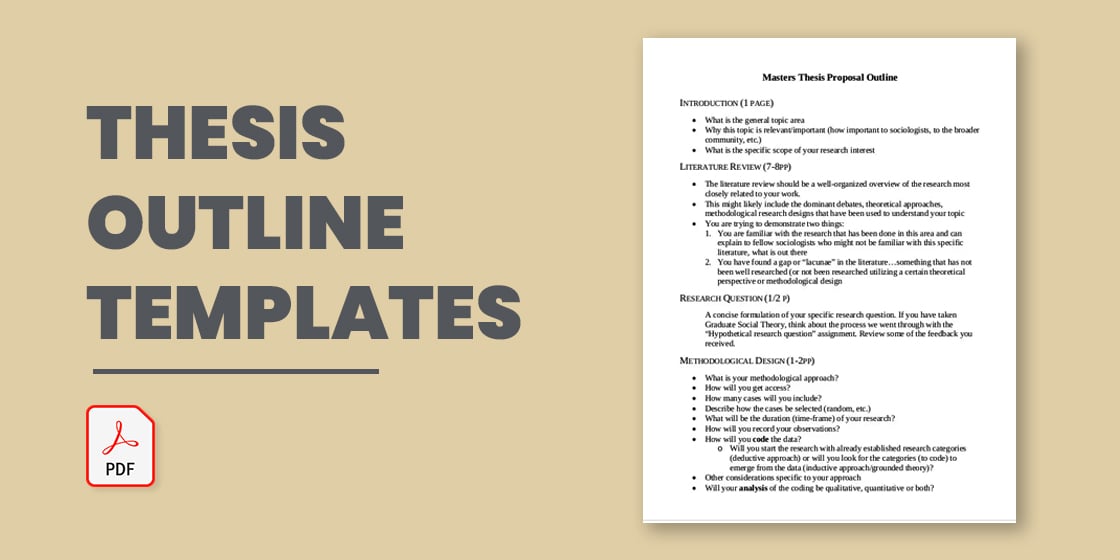
Thesis Proposal Outline Template

- Google Docs
- Apple Pages
Thesis Proposal Gantt Chart Outline Template
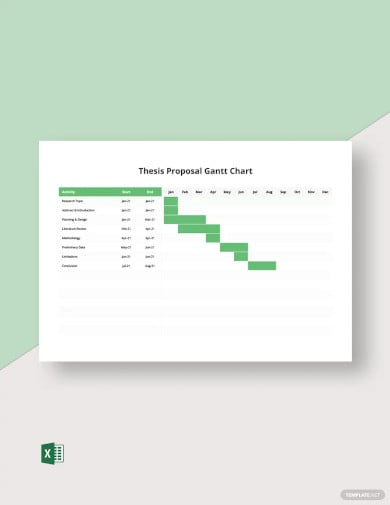
Free Master Thesis Outline Template
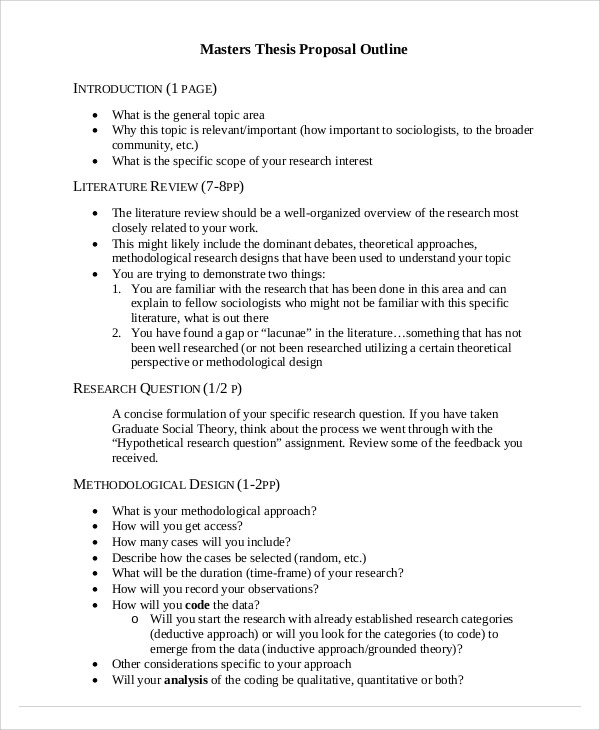
Free Traditional Senior Thesis Outline Template
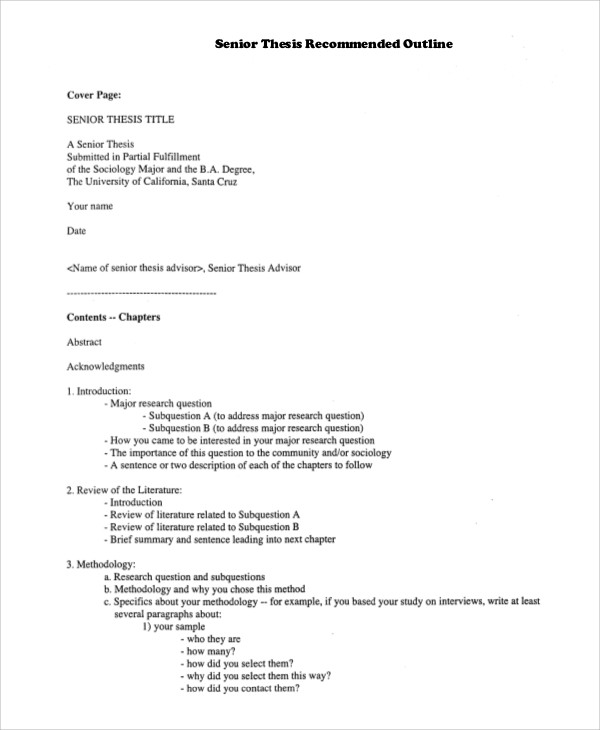
Thesis Outline Templates
- The topic of your thesis and the target audience.
- Then comes the introduction of the thesis and the thesis sample statement . The introduction includes a brief introduction to your thesis, and it should conclude with your thesis statement. A thesis statement is generally the last sentence of the introduction part.
- The body is the most important part of your thesis. Your entire content of the thesis should be included in the body of your thesis.
- Finally, the conclusion is written at the end of your thesis.
Free Thesis Statement Outline Template
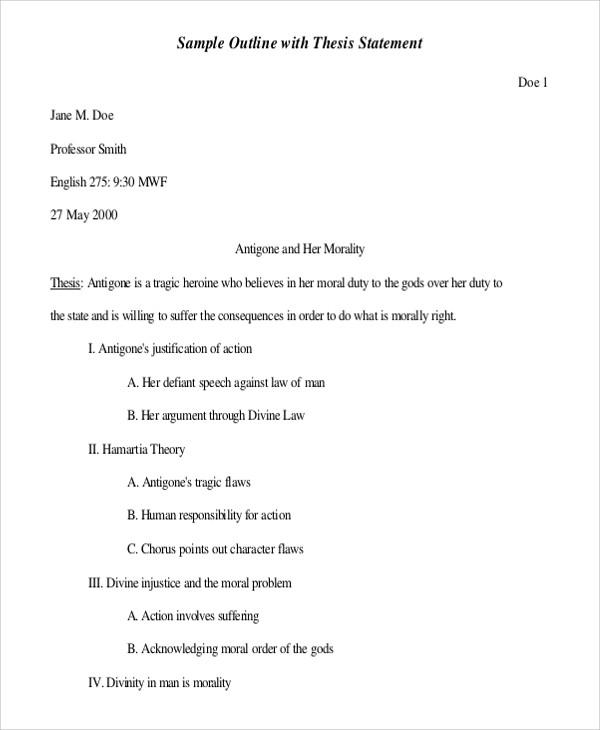
- Then comes the introduction of the thesis and the thesis personal statement . The introduction includes a brief introduction to your thesis, and it should conclude with your thesis sample statement . A thesis statement is generally the last sentence of the introduction part.
Free Outline for Thesis Proposal Template
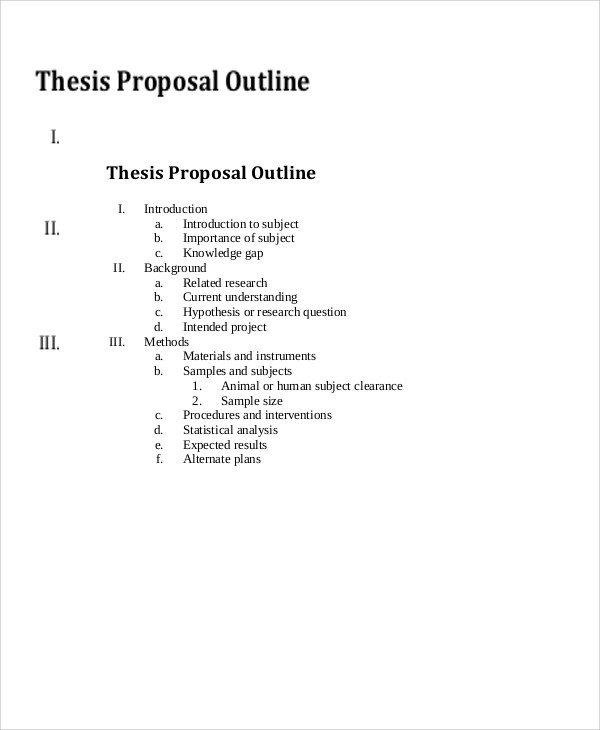
How to Create a Thesis Outline Template
- Be aware of the kind of thesis study that you would like to create so you can decide on the outline format that you may use.
- Download any of the outline templates that we have provided in this post so you can be guided by formatting the layout and content of your thesis outline template.
- Enumerate all the items that are needed to be present in your research and plot them accordingly on the formal template that you will use.
What Should a Thesis Outline Look Like
- It must contain the introduction of the research study.
- A literature review is essential to ensure the need for the study to push through.
- The research questions that need to be answered should also be stated.
- A methodological design must be included in the discussion within a thesis outline.
- The assessment sheet to be followed by the research study once information has already been gathered must also be presented
- Properly incorporate the way that a conclusion and recommendation may be stated based on the relation of the hypothesis to the results of the study. You can also see more on Email Outline .
Free University Honors Thesis Outline Template
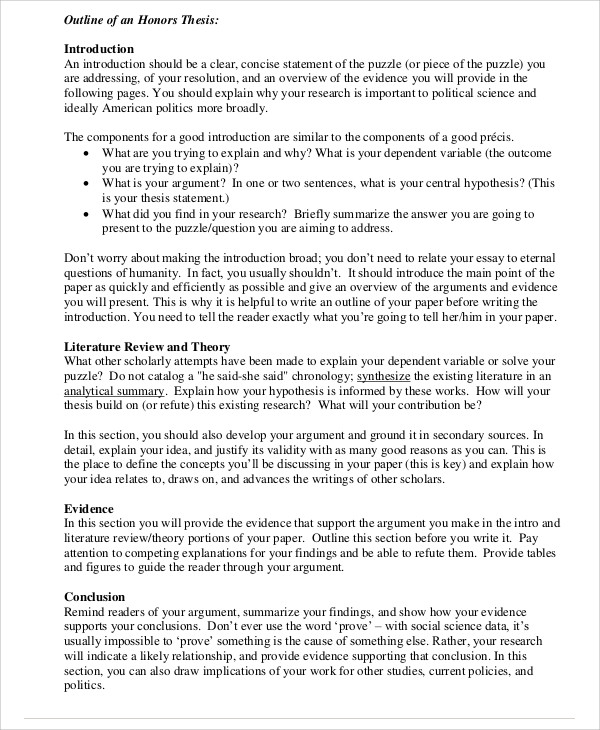
Free Sample Thesis Essay Outline Template
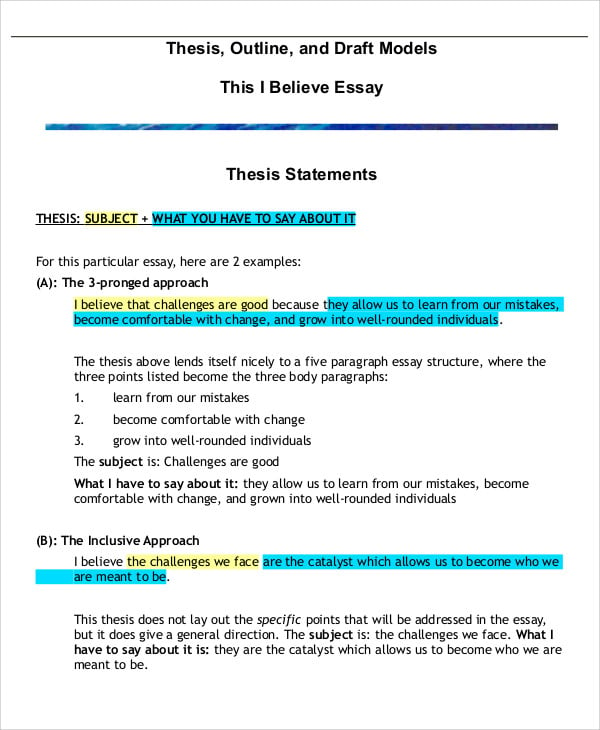
Free High School Academic Thesis Outline Template
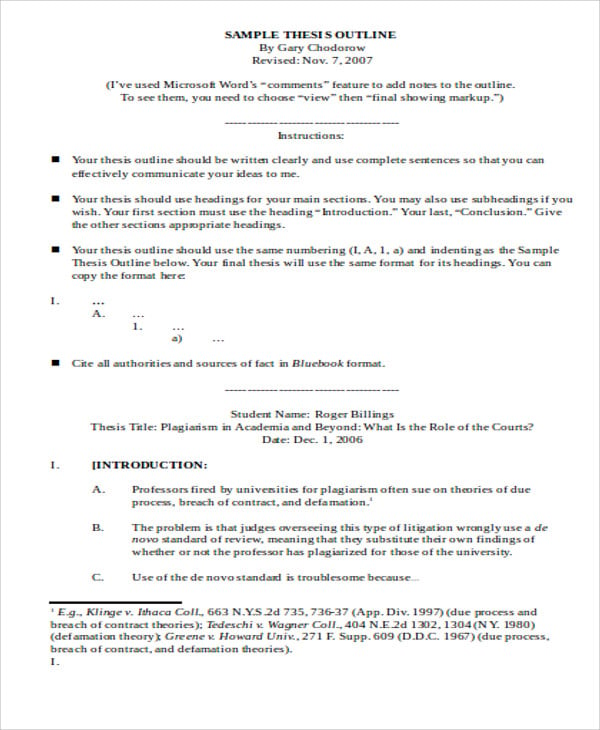
Free Thesis Paper Outline with Informative Introduction
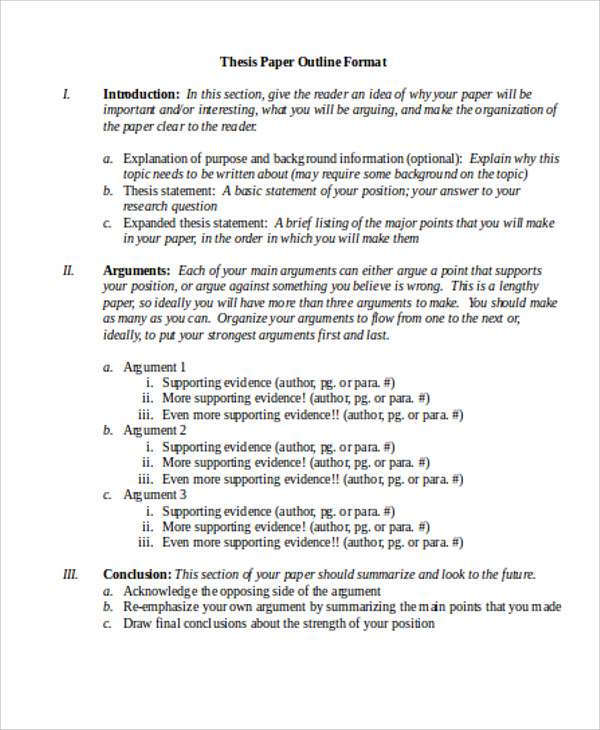
Free APA Thesis Outline Template
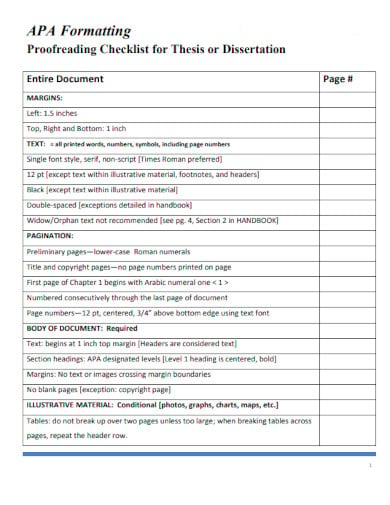
Free MLA Research Paper Thesis Outline Template
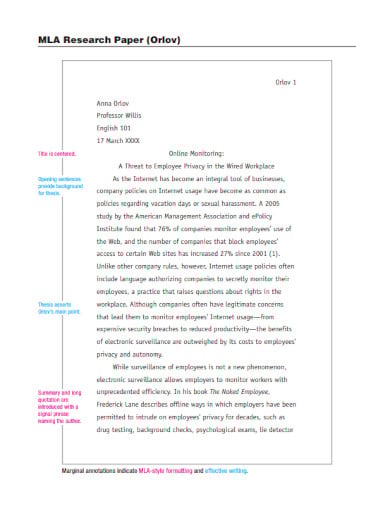
Free Student Thesis Outline Form Template
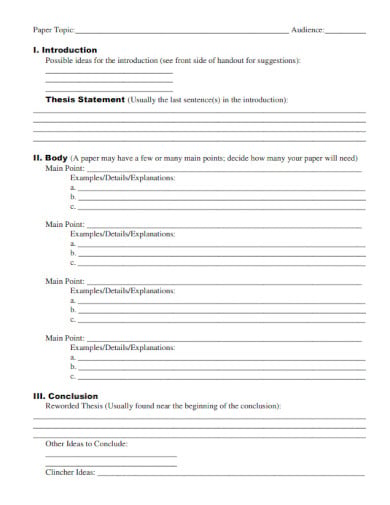
Free Baby Thesis Outline in PDF Format
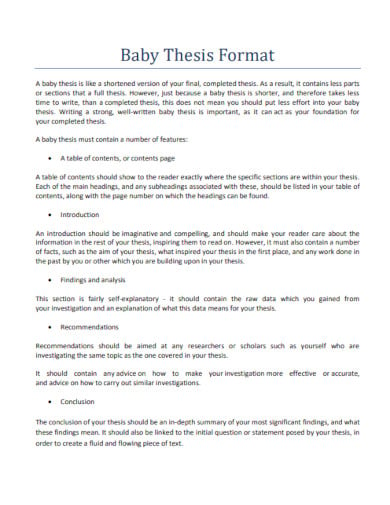
Free Environmental Science Thesis Outline Template
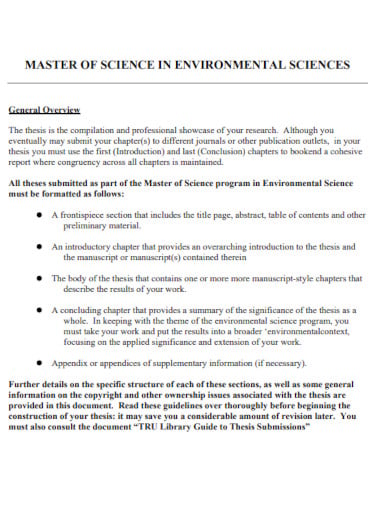
Guidelines in Creating a Thesis Outline
- Assure that the outline template that you will use may it be in MS Word format, PDF format, or MS Excel format is appropriate to the thesis or research study that you will conduct.
- Be precise with the items that you will put in the thesis outline and make sure that they are relevant to the study that you want to immerse yourself into. You can also see more on Sign Outline.
- Properly present the topic area which will generally be discussed and researched.
- Identify the reasons why the research is important. You can specify how it can benefit a community and the other stakeholders of the research activity.
- Be specific with the group of people to whom the results of the thesis will be highly usable.
- Your thesis outline must present the scope and limitations of the research interest. You can also see more on Memo Outline .
More in Outline Templates
- 10+ Training Outline Templates – PDF, Word, Apple Pages
- 24+ Autobiography Outline Templates & Samples – DOC, PDF
- 10+ Project Proposal Outline in Google Docs | MS Word | Pages | Editable PDF | InDesign | Photoshop | Publisher | PDF
- 12+ Literature Review Outline Templates – PDF, DOC
- 11+ Outline Report Templates in Google Docs | Word | Pages | PDF
- 10+ Production Outline Templates
- 12+ Project Outline Templates in Google Docs | Word | Pages | PDF | XLS
- 15+ Meeting Outline Templates in PDF | DOC
- 8+ Project Proposal Outline Templates
- 12+ Outline Templates in Apple Pages
- 10+ Outline Templates in Word
- 10+ Outline Templates
- 15+ Topic Proposal Outline Templates – PDF, Word
- 12+ Research Project Proposal Outline Templates – PDF, Word, Pages
File Formats
Word templates, google docs templates, excel templates, powerpoint templates, google sheets templates, google slides templates, pdf templates, publisher templates, psd templates, indesign templates, illustrator templates, pages templates, keynote templates, numbers templates, outlook templates.
Have a language expert improve your writing
Run a free plagiarism check in 10 minutes, generate accurate citations for free.
- Knowledge Base
- How to write an essay outline | Guidelines & examples
How to Write an Essay Outline | Guidelines & Examples
Published on August 14, 2020 by Jack Caulfield . Revised on July 23, 2023.
An essay outline is a way of planning the structure of your essay before you start writing. It involves writing quick summary sentences or phrases for every point you will cover in each paragraph , giving you a picture of how your argument will unfold.
Instantly correct all language mistakes in your text
Upload your document to correct all your mistakes in minutes

Table of contents
Organizing your material, presentation of the outline, examples of essay outlines, other interesting articles, frequently asked questions about essay outlines.
At the stage where you’re writing an essay outline, your ideas are probably still not fully formed. You should know your topic and have already done some preliminary research to find relevant sources , but now you need to shape your ideas into a structured argument.
Creating categories
Look over any information, quotes and ideas you’ve noted down from your research and consider the central point you want to make in the essay—this will be the basis of your thesis statement . Once you have an idea of your overall argument, you can begin to organize your material in a way that serves that argument.
Try to arrange your material into categories related to different aspects of your argument. If you’re writing about a literary text, you might group your ideas into themes; in a history essay, it might be several key trends or turning points from the period you’re discussing.
Three main themes or subjects is a common structure for essays. Depending on the length of the essay, you could split the themes into three body paragraphs, or three longer sections with several paragraphs covering each theme.
As you create the outline, look critically at your categories and points: Are any of them irrelevant or redundant? Make sure every topic you cover is clearly related to your thesis statement.
Order of information
When you have your material organized into several categories, consider what order they should appear in.
Your essay will always begin and end with an introduction and conclusion , but the organization of the body is up to you.
Consider these questions to order your material:
- Is there an obvious starting point for your argument?
- Is there one subject that provides an easy transition into another?
- Do some points need to be set up by discussing other points first?
Receive feedback on language, structure, and formatting
Professional editors proofread and edit your paper by focusing on:
- Academic style
- Vague sentences
- Style consistency
See an example

Within each paragraph, you’ll discuss a single idea related to your overall topic or argument, using several points of evidence or analysis to do so.
In your outline, you present these points as a few short numbered sentences or phrases.They can be split into sub-points when more detail is needed.
The template below shows how you might structure an outline for a five-paragraph essay.
- Thesis statement
- First piece of evidence
- Second piece of evidence
- Summary/synthesis
- Importance of topic
- Strong closing statement
You can choose whether to write your outline in full sentences or short phrases. Be consistent in your choice; don’t randomly write some points as full sentences and others as short phrases.
Examples of outlines for different types of essays are presented below: an argumentative, expository, and literary analysis essay.
Argumentative essay outline
This outline is for a short argumentative essay evaluating the internet’s impact on education. It uses short phrases to summarize each point.
Its body is split into three paragraphs, each presenting arguments about a different aspect of the internet’s effects on education.
- Importance of the internet
- Concerns about internet use
- Thesis statement: Internet use a net positive
- Data exploring this effect
- Analysis indicating it is overstated
- Students’ reading levels over time
- Why this data is questionable
- Video media
- Interactive media
- Speed and simplicity of online research
- Questions about reliability (transitioning into next topic)
- Evidence indicating its ubiquity
- Claims that it discourages engagement with academic writing
- Evidence that Wikipedia warns students not to cite it
- Argument that it introduces students to citation
- Summary of key points
- Value of digital education for students
- Need for optimism to embrace advantages of the internet
Expository essay outline
This is the outline for an expository essay describing how the invention of the printing press affected life and politics in Europe.
The paragraphs are still summarized in short phrases here, but individual points are described with full sentences.
- Claim that the printing press marks the end of the Middle Ages.
- Provide background on the low levels of literacy before the printing press.
- Present the thesis statement: The invention of the printing press increased circulation of information in Europe, paving the way for the Reformation.
- Discuss the very high levels of illiteracy in medieval Europe.
- Describe how literacy and thus knowledge and education were mainly the domain of religious and political elites.
- Indicate how this discouraged political and religious change.
- Describe the invention of the printing press in 1440 by Johannes Gutenberg.
- Show the implications of the new technology for book production.
- Describe the rapid spread of the technology and the printing of the Gutenberg Bible.
- Link to the Reformation.
- Discuss the trend for translating the Bible into vernacular languages during the years following the printing press’s invention.
- Describe Luther’s own translation of the Bible during the Reformation.
- Sketch out the large-scale effects the Reformation would have on religion and politics.
- Summarize the history described.
- Stress the significance of the printing press to the events of this period.
Literary analysis essay outline
The literary analysis essay outlined below discusses the role of theater in Jane Austen’s novel Mansfield Park .
The body of the essay is divided into three different themes, each of which is explored through examples from the book.
- Describe the theatricality of Austen’s works
- Outline the role theater plays in Mansfield Park
- Introduce the research question : How does Austen use theater to express the characters’ morality in Mansfield Park ?
- Discuss Austen’s depiction of the performance at the end of the first volume
- Discuss how Sir Bertram reacts to the acting scheme
- Introduce Austen’s use of stage direction–like details during dialogue
- Explore how these are deployed to show the characters’ self-absorption
- Discuss Austen’s description of Maria and Julia’s relationship as polite but affectionless
- Compare Mrs. Norris’s self-conceit as charitable despite her idleness
- Summarize the three themes: The acting scheme, stage directions, and the performance of morals
- Answer the research question
- Indicate areas for further study
If you want to know more about AI tools , college essays , or fallacies make sure to check out some of our other articles with explanations and examples or go directly to our tools!
- Ad hominem fallacy
- Post hoc fallacy
- Appeal to authority fallacy
- False cause fallacy
- Sunk cost fallacy
College essays
- Choosing Essay Topic
- Write a College Essay
- Write a Diversity Essay
- College Essay Format & Structure
- Comparing and Contrasting in an Essay
(AI) Tools
- Grammar Checker
- Paraphrasing Tool
- Text Summarizer
- AI Detector
- Plagiarism Checker
- Citation Generator
Here's why students love Scribbr's proofreading services
Discover proofreading & editing
You will sometimes be asked to hand in an essay outline before you start writing your essay . Your supervisor wants to see that you have a clear idea of your structure so that writing will go smoothly.
Even when you do not have to hand it in, writing an essay outline is an important part of the writing process . It’s a good idea to write one (as informally as you like) to clarify your structure for yourself whenever you are working on an essay.
If you have to hand in your essay outline , you may be given specific guidelines stating whether you have to use full sentences. If you’re not sure, ask your supervisor.
When writing an essay outline for yourself, the choice is yours. Some students find it helpful to write out their ideas in full sentences, while others prefer to summarize them in short phrases.
You should try to follow your outline as you write your essay . However, if your ideas change or it becomes clear that your structure could be better, it’s okay to depart from your essay outline . Just make sure you know why you’re doing so.
Cite this Scribbr article
If you want to cite this source, you can copy and paste the citation or click the “Cite this Scribbr article” button to automatically add the citation to our free Citation Generator.
Caulfield, J. (2023, July 23). How to Write an Essay Outline | Guidelines & Examples. Scribbr. Retrieved June 24, 2024, from https://www.scribbr.com/academic-essay/essay-outline/
Is this article helpful?

Jack Caulfield
Other students also liked, how to create a structured research paper outline | example, a step-by-step guide to the writing process, how to write an argumentative essay | examples & tips, what is your plagiarism score.

AI Generator
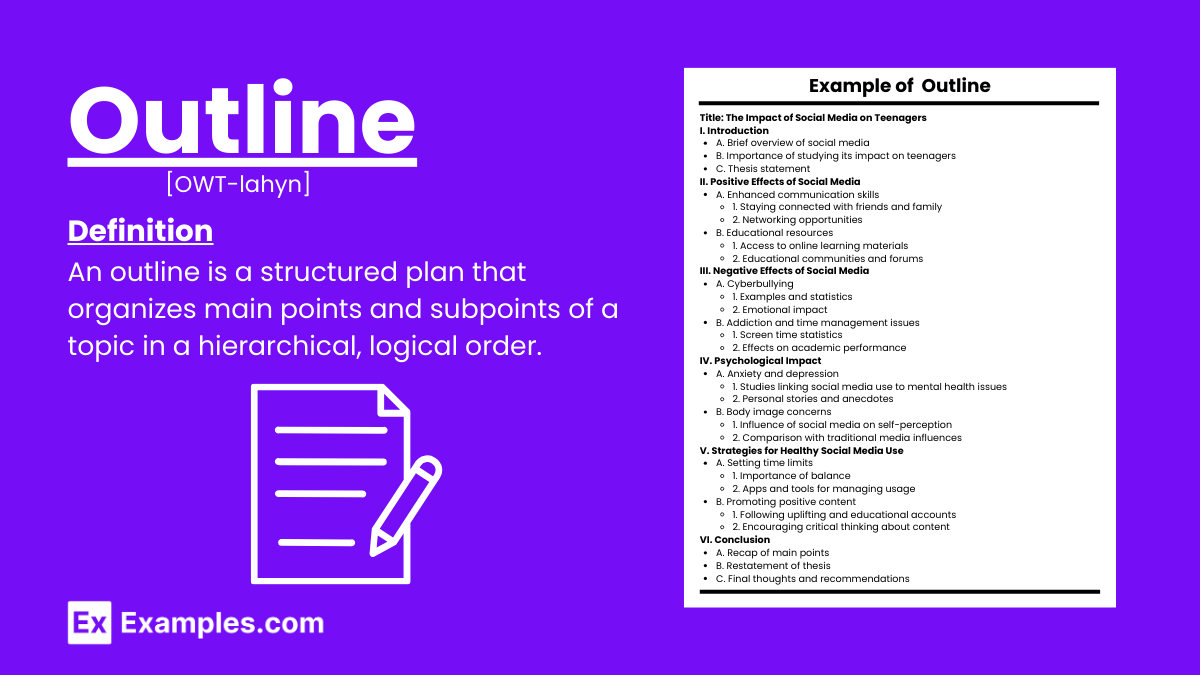
A well-written report or speech is most likely the result of an outline. Delivery of a speech or submission of a report is only part of the whole process of making that article . Without a plan, there is no act of doing or action. For example, going into battle without strategy is like running head-on towards a sword. Suicide.
Outline template and speech outline examples in the page show that having an outline to a speech is always helpful and provide guidance to the direction of an article. Scroll down the page to get a better look at other samples.
What is an Outline in Writing?
An outline in writing is a structured plan that organizes main ideas and supporting details before drafting a text. It helps writers logically arrange their thoughts, ensuring clarity and coherence. Outlines can be formal, with numbered headings and subheadings, or informal, using bullet points. They serve as a roadmap for the writing process, aiding in the development of a clear and effective composition.
What Is the Format of a Standard Outline?
A standard outline helps organize ideas and structure information logically. Here’s a common format for a standard outline, often used for essays , research papers, or presentations:
I. Introduction
A. Background information B. Purpose or thesis statement
II. Main Point 1
A. Subpoint 1 1. Detail or example 2. Detail or example B. Subpoint 2 1. Detail or example 2. Detail or example
III. Main Point 2
Iv. main point 3, v. conclusion.
A. Summary of main points B. Restate thesis or main purpose C. Closing thoughts or call to action
Outline Example for Research
Topic : The Effects of Climate Change on Coral Reefs I. Introduction A. Hook : Start with a compelling statistic or fact about coral reef degradation. B. Background Information : Briefly explain what coral reefs are and their ecological importance. C. Thesis Statement : Climate change significantly affects coral reefs by causing coral bleaching, ocean acidification, and disrupting marine ecosystems. II. Coral Bleaching A. Definition and Process Explain what coral bleaching is. B. Causes Rising sea temperatures C. Consequences Loss of vibrant coral colors III. Ocean Acidification A. Definition and Process Define ocean acidification. B. Effects on Coral Reefs Weakening of coral skeletons C. Broader Implications Impact on marine biodiversity IV. Disruption of Marine Ecosystems A. Changes in Species Composition Shifts in dominant species B. Impact on Fish Populations Decline in fish populations reliant on coral reefs C. Ecological Balance Altered predator-prey relationships V. Mitigation and Conservation Efforts A. Coral Restoration Projects Coral farming and transplantation B. Reducing Carbon Footprint Global efforts to reduce greenhouse gas emissions C. Public Awareness and Education Campaigns to raise awareness about coral reef conservation VI. Conclusion A. Restate Thesis : Recap the significant effects of climate change on coral reefs. B. Summary of Main Points : Briefly summarize the key points discussed. C. Call to Action : Emphasize the importance of continued efforts in conservation and climate action to protect coral reefs.
Outline Example for Essay
Topic : The Benefits of Renewable Energy I. Introduction A. Hook : Start with a compelling fact about the rise of renewable energy usage worldwide. B. Background Information : Briefly explain what renewable energy is and its importance. C. Thesis Statement : Renewable energy offers numerous benefits including environmental protection, economic growth, and energy security. II. Environmental Protection A. Reduction in Greenhouse Gas Emissions Lower carbon footprint compared to fossil fuels Mitigation of climate change effects B. Decrease in Air Pollution Cleaner air quality Health benefits from reduced respiratory and cardiovascular diseases C. Conservation of Natural Resources Sustainable use of resources like wind, solar, and water Preservation of ecosystems and biodiversity III. Economic Growth A. Job Creation Employment opportunities in renewable energy sectors Training and education for green jobs B. Energy Independence Reduced reliance on imported fossil fuels Stabilization of energy prices C. Investment Opportunities Growth in renewable energy markets Attraction of private and public investments IV. Energy Security A. Reliability and Resilience Diverse energy sources reducing risk of supply disruption Localized energy production enhancing resilience to natural disasters B. Technological Advancements Innovations in energy storage and grid management Improvements in efficiency and cost-effectiveness C. Long-term Sustainability Unlimited supply of renewable resources Future-proof energy solutions for generations to come V. Conclusion A. Restate Thesis : Summarize the key benefits of renewable energy. B. Summary of Main Points : Recap the environmental, economic, and energy security advantages discussed. C. Call to Action : Encourage the adoption and support of renewable energy initiatives to ensure a sustainable future.
Outline Example for Speech
Topic : The Importance of Healthy Eating I. Introduction A. Hook : Share an engaging statistic or anecdote about the impact of diet on health. B. Importance of Topic : Explain why healthy eating is crucial for overall well-being. C. Thesis Statement : Healthy eating is essential for maintaining physical health, improving mental well-being, and boosting energy levels. II. Maintaining Physical Health A. Nutritional Benefits Provides essential vitamins and minerals Supports immune system function B. Disease Prevention Reduces risk of chronic diseases like heart disease and diabetes Helps maintain a healthy weight C. Longevity Contributes to a longer lifespan Improves quality of life in later years III. Improving Mental Well-being A. Mood Regulation Impact of nutrients on brain chemistry Foods that promote serotonin production B. Cognitive Function Omega-3 fatty acids and brain health Antioxidants and memory improvement C. Stress Reduction Effects of a balanced diet on stress levels Importance of regular meal times and hydration IV. Boosting Energy Levels A. Balanced Diet Role of carbohydrates, proteins, and fats Importance of portion control B. Sustained Energy Benefits of complex carbohydrates Avoiding energy crashes with balanced meals C. Hydration Importance of water for energy Effects of dehydration on physical and mental performance V. Conclusion A. Restate Thesis : Reiterate the importance of healthy eating for physical health, mental well-being, and energy levels. B. Summary of Main Points : Briefly recap the key points discussed. C. Call to Action : Encourage the audience to adopt healthier eating habits and make informed food choices.
Resume Outline Example
Creating a well-structured resume is crucial for making a strong impression on potential employers. Here is an example outline for a resume:
I. Contact Information Full Name Address Phone Number Email Address LinkedIn Profile (optional) Professional Website/Portfolio (optional) II. Objective or Summary Statement Objective Statement : A brief statement of your career goals and what you aim to achieve in the desired position. Summary Statement : A concise summary of your professional background, key skills, and achievements. III. Professional Experience Job Title Company Name , Location (City, State) Dates of Employment (Month, Year – Month, Year) Key Responsibilities and Achievements : Bullet point describing a major responsibility or achievement. Bullet point describing another major responsibility or achievement. Bullet point describing a quantifiable result or improvement. IV. Education Degree Earned (e.g., Bachelor of Arts in English) Institution Name , Location (City, State) Graduation Date (Month, Year) Relevant Coursework or Honors (optional) V. Skills Technical Skills : List specific technical skills relevant to the job (e.g., software proficiency, programming languages). Soft Skills : List key interpersonal skills (e.g., communication, teamwork, leadership). Language Skills : List any foreign languages spoken and proficiency level. VI. Certifications and Licenses Certification Name Issuing Organization Date Earned (Month, Year) Relevant Details or Coursework (optional) VII. Professional Affiliations Organization Name Role/Title Dates of Membership Key Contributions or Involvement (optional) VIII. Volunteer Experience (optional) Role/Title Organization Name , Location (City, State) Dates of Involvement (Month, Year – Month, Year) Key Responsibilities and Achievements : Bullet point describing a major responsibility or achievement. Bullet point describing another major responsibility or achievement. IX. Awards and Honors (optional) Award Name Issuing Organization Date Received (Month, Year) Brief Description of the Award (optional) X. Publications and Presentations (optional) Title of Publication or Presentation Venue or Journal Name Date of Publication or Presentation (Month, Year) Brief Description or Link to the Work (optional)
Paragraph Outline Examples
Creating a paragraph outline helps structure individual paragraphs within a larger piece of writing. Here are some examples of paragraph outlines for different types of paragraphs:
1. Descriptive Paragraph Outline
Topic : A Day at the Beach I. Topic Sentence Introduce the main idea: Describe the atmosphere and experience of a day at the beach. II. Supporting Details Sight : Describe the clear blue sky, the shimmering water, and the golden sand. Sound : Mention the sound of waves crashing, children laughing, and seagulls calling. Smell : Describe the salty sea air mixed with the scent of sunscreen. Touch : Explain the feeling of warm sand underfoot and the cool splash of ocean water. Taste : Mention the taste of salty sea air and snacks like ice cream or fresh fruit. III. Concluding Sentence Summarize the sensory details and reiterate the enjoyment of a day at the beach.
2. Narrative Paragraph Outline
Topic : The Day I Learned to Ride a Bike I. Topic Sentence Introduce the main idea: Narrate the experience of learning to ride a bike. II. Supporting Details Setting the Scene : Describe the location, time of day, and initial feelings of excitement and nervousness. First Attempts : Explain the initial wobbles, falls, and encouragement from a parent or friend. Breakthrough Moment : Describe the moment of balance and realization of riding independently. Feelings : Detail the emotions of triumph, freedom, and pride. Aftermath : Mention the newfound confidence and desire to ride again. III. Concluding Sentence Reflect on the significance of the experience and its impact on personal growth.
3. Expository Paragraph Outline
Topic : The Benefits of Reading Books I. Topic Sentence Introduce the main idea: Explain the benefits of reading books. II. Supporting Details Knowledge Expansion : Discuss how reading books broadens knowledge and understanding of various subjects. Cognitive Benefits : Explain how reading improves concentration, critical thinking, and memory. Stress Reduction : Describe the calming effect of reading and its ability to reduce stress. Empathy and Understanding : Highlight how reading fiction can increase empathy by exposing readers to different perspectives. Vocabulary and Language Skills : Mention the improvement in vocabulary and language skills through regular reading. III. Concluding Sentence Summarize the benefits and encourage the reader to incorporate more reading into their routine.
Simple Outline Example
A simple outline helps organize ideas and structure a piece of writing effectively. Here is a straightforward example:
Topic : The Benefits of Exercise I. Introduction A. Hook : Start with an interesting fact or statistic about exercise. B. Background Information : Briefly explain what exercise is and its general importance. C. Thesis Statement : Exercise provides numerous benefits for physical health, mental well-being, and overall quality of life. II. Physical Health Benefits A. Weight Management Helps maintain a healthy weight Prevents obesity-related diseases B. Cardiovascular Health Strengthens the heart Reduces the risk of heart disease C. Muscle and Bone Strength Builds and maintains muscle mass Enhances bone density III. Mental Well-being Benefits A. Stress Reduction Releases endorphins Lowers cortisol levels B. Improved Mood Reduces symptoms of depression and anxiety Enhances overall mood C. Better Sleep Promotes deeper and more restful sleep Helps regulate sleep patterns IV. Overall Quality of Life A. Increased Energy Levels Boosts stamina and endurance Reduces feelings of fatigue B. Enhanced Longevity Contributes to a longer lifespan Improves quality of life in later years C. Social Benefits Encourages social interaction through group activities Builds a sense of community and support V. Conclusion A. Restate Thesis : Summarize the key benefits of exercise. B. Summary of Main Points : Recap the physical, mental, and overall quality of life benefits. C. Call to Action : Encourage the audience to incorporate regular exercise into their daily routine for a healthier and happier life.
More Samples & Examples of Outline in PDF
1. analytical essay sample outline.

2. Formal Essay Outline
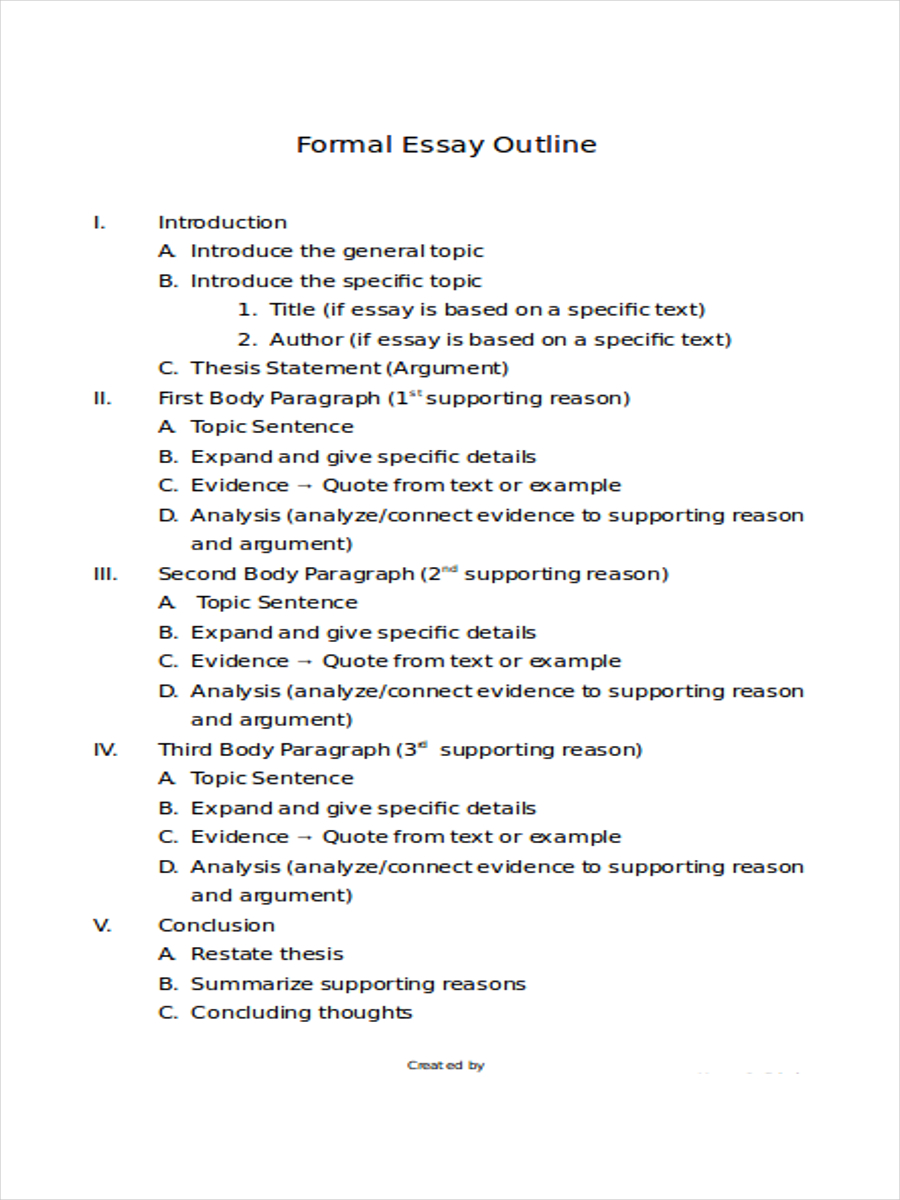
3. General Protocol Outline
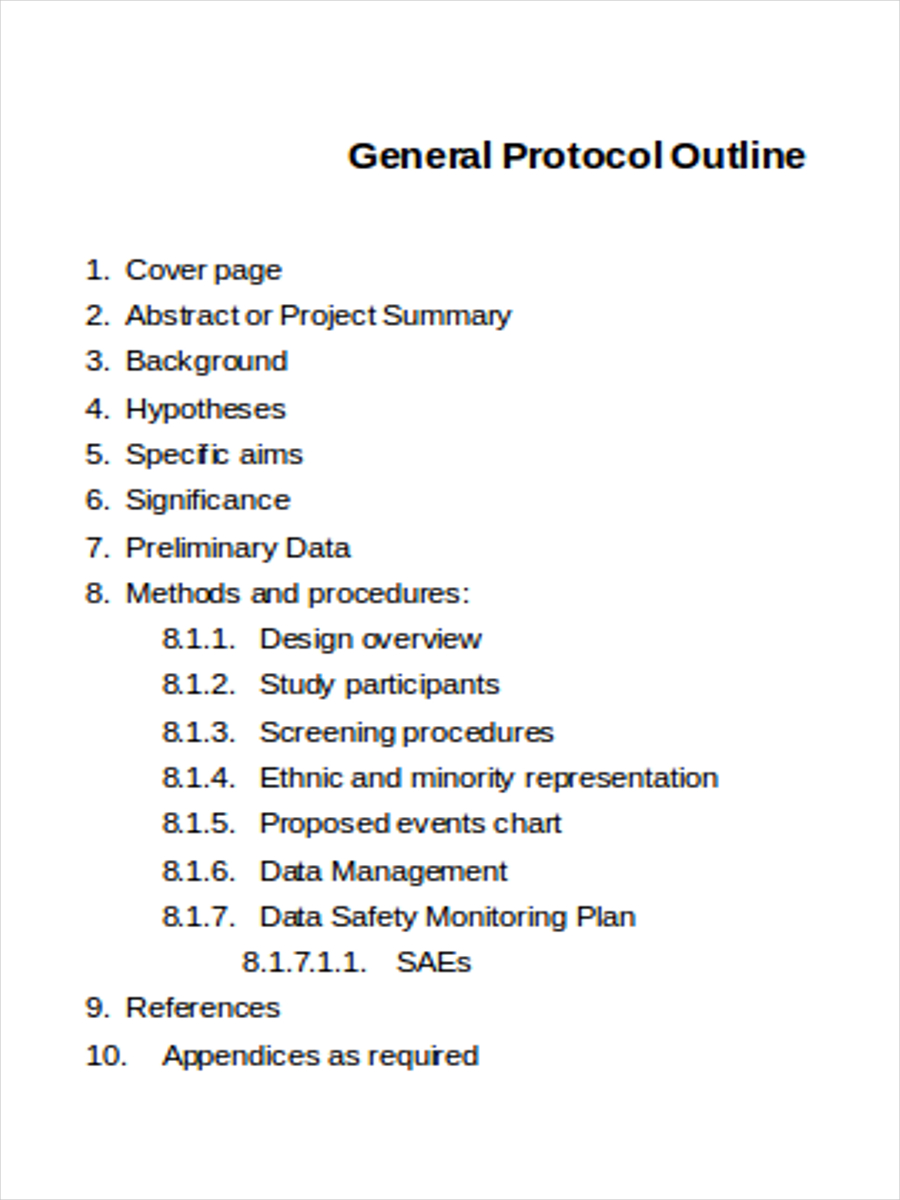
4. Research Protocol Sample Outline
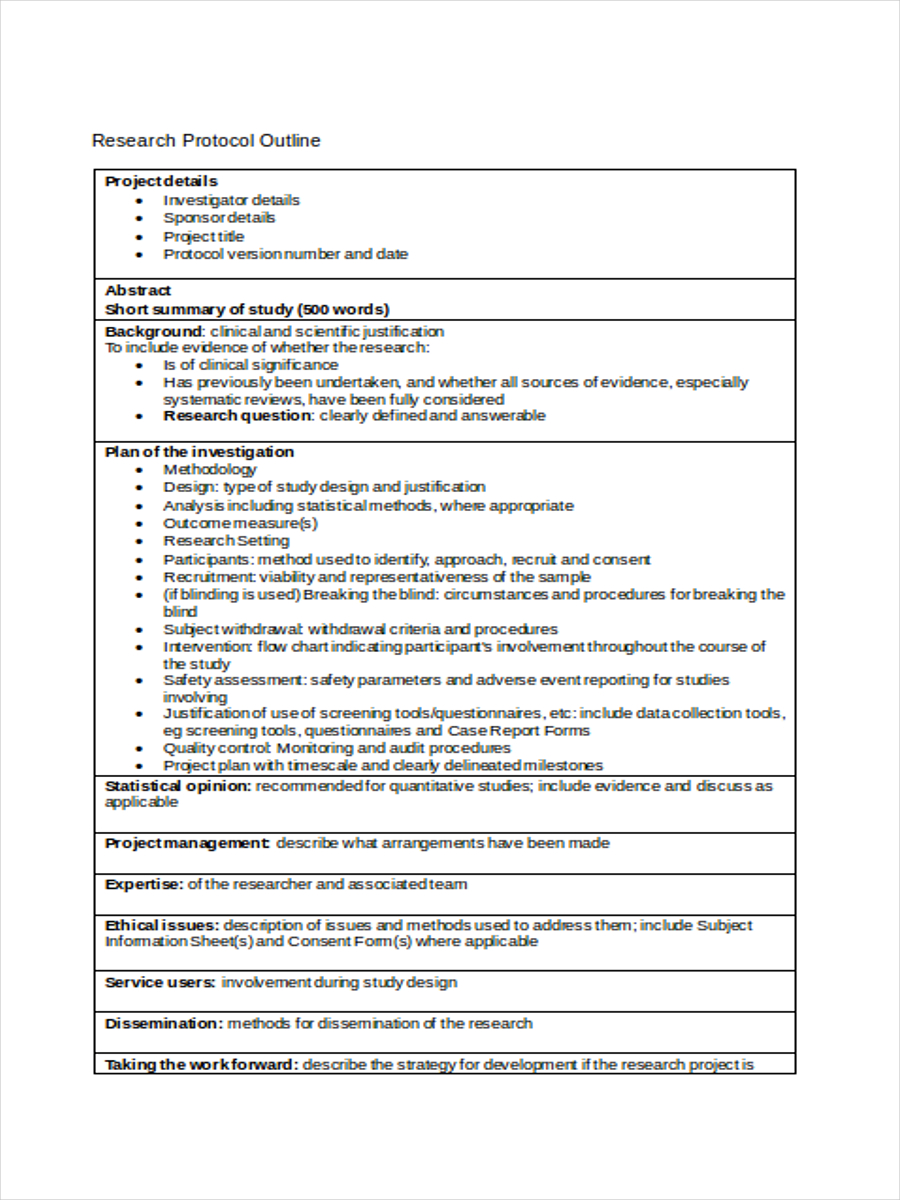
5. Project Plan Outline
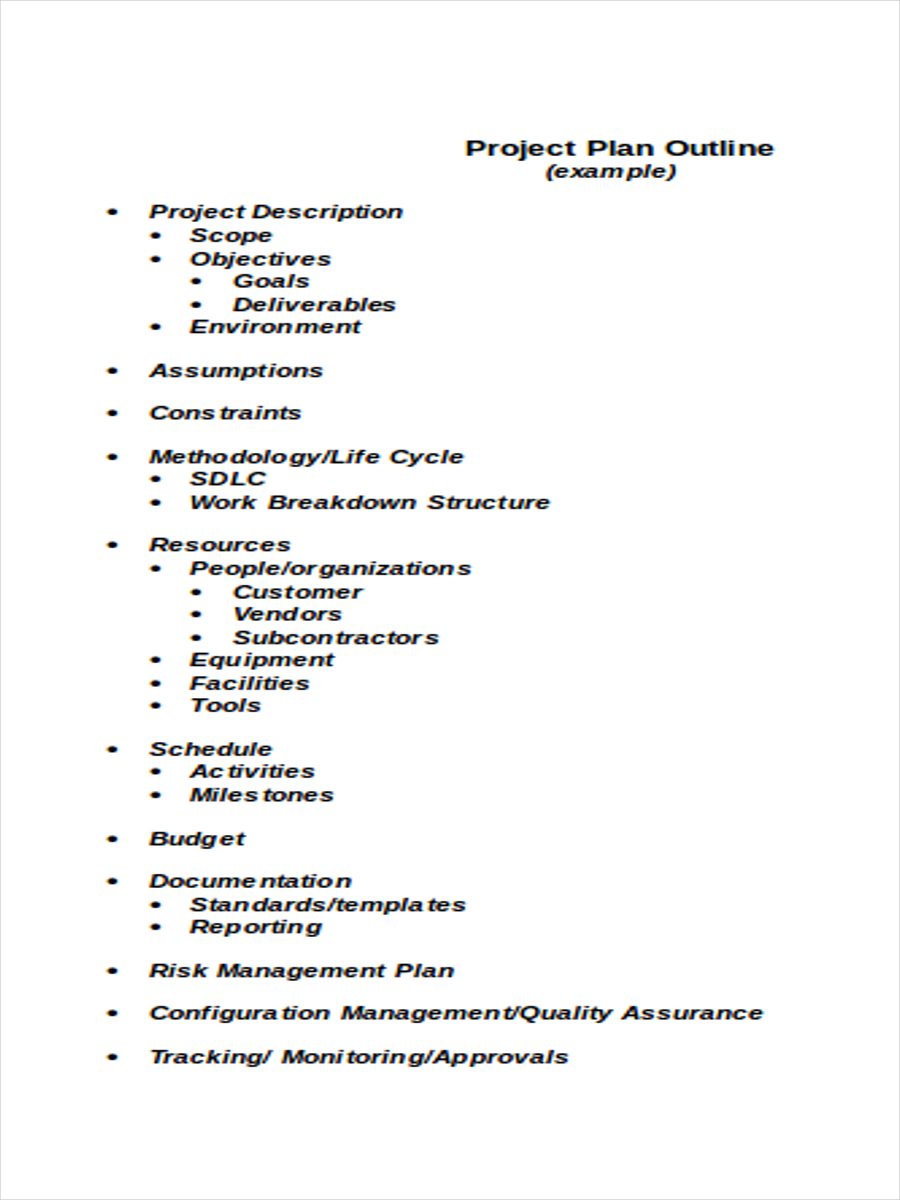
6. Business Plan Sample Outline
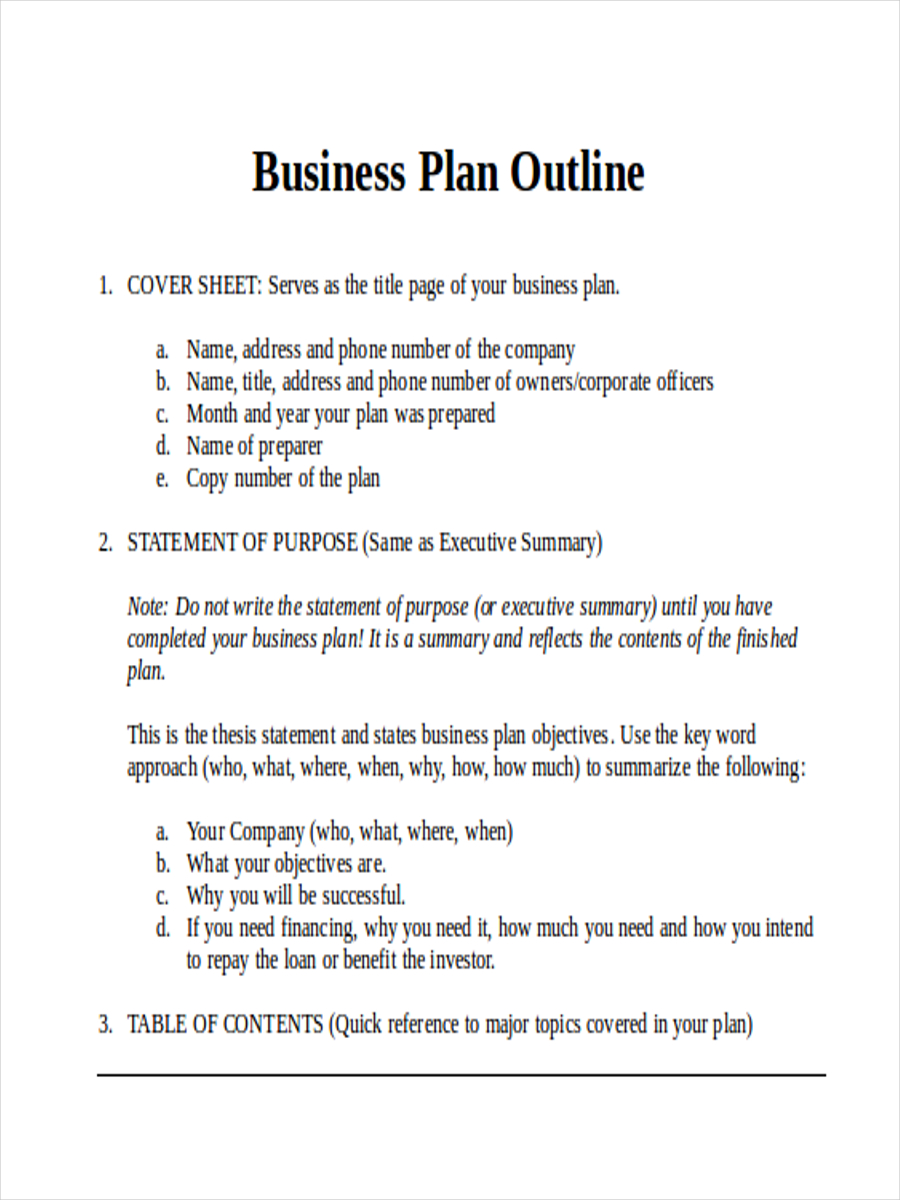
7. Professional Resume Outline
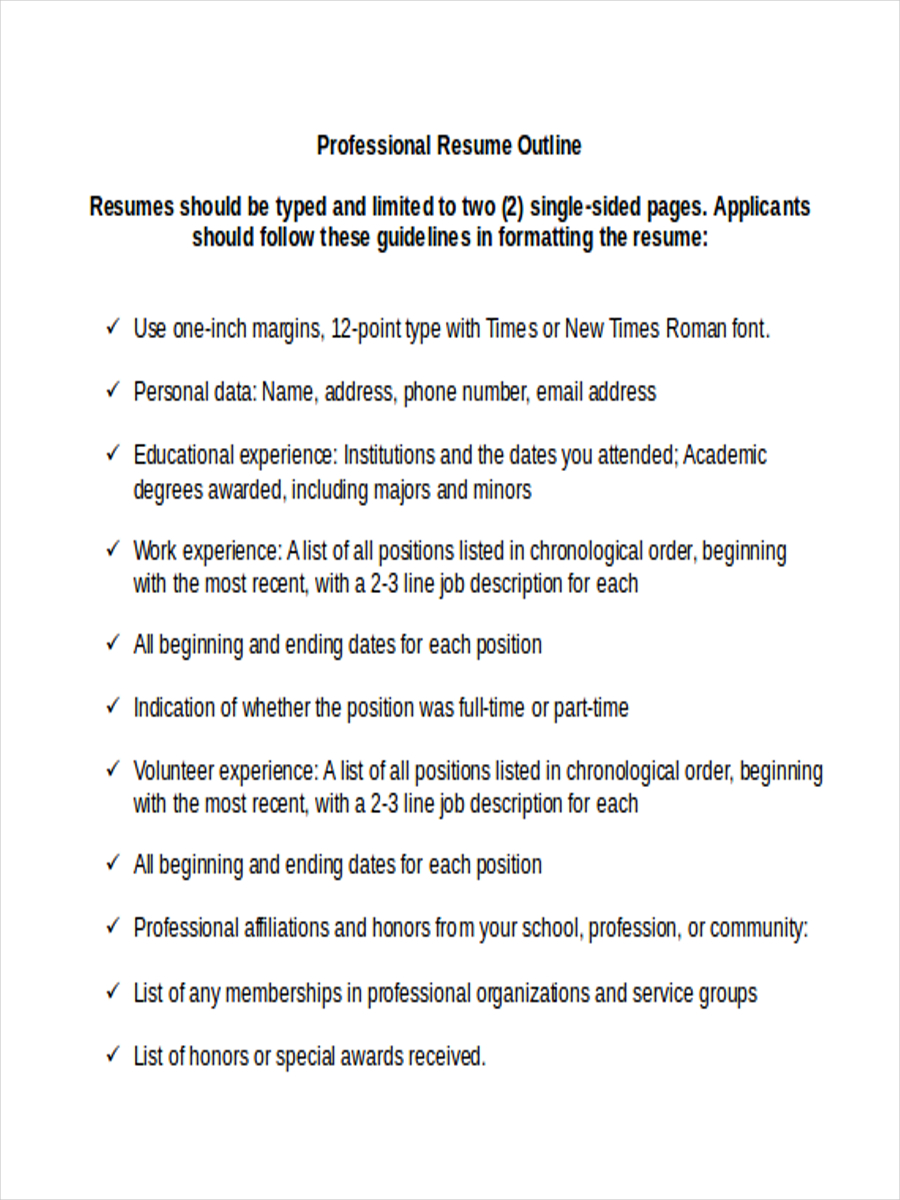
Uses of an Outline
An outline serves multiple purposes in the writing process, aiding both planning and execution. Here are the key uses:
1. Organizing Ideas
- Clarity : Helps in arranging thoughts logically.
- Structure : Provides a framework for the writing.
2. Guiding the Writing Process
- Roadmap : Acts as a guide during drafting.
- Focus : Keeps the writer on track with the main points.
3. Enhancing Coherence and Flow
- Logical Progression : Ensures ideas flow logically from one to another.
- Connection : Helps in linking paragraphs and sections smoothly.
4. Improving Time Management
- Efficiency : Speeds up the writing process by providing a clear plan.
- Deadlines : Helps in meeting writing deadlines by organizing tasks.
5. Facilitating Revision and Editing
- Overview : Offers a bird’s-eye view for easy identification of weak points.
- Adjustments : Simplifies the process of restructuring and refining ideas.
6. Aiding Collaboration
- Shared Vision : Provides a common framework for group writing projects.
- Coordination : Helps team members stay aligned with the overall plan.
7. Enhancing Persuasiveness
- Strong Argument : Ensures all points support the thesis effectively.
- Balanced Presentation : Allows for the inclusion of counterarguments and their rebuttals.
8. Assisting in Complex Projects
- Detailed Planning : Breaks down large projects into manageable parts.
- Milestones : Helps in setting and achieving intermediate goals.
Guidelines for Writing an Outline

Creating an effective outline involves several key steps to ensure clarity and coherence. Here are the essential guidelines:
1. Understand the Purpose
- Clarify the Goal : Know the purpose of your writing and what you aim to achieve.
- Identify the Audience : Tailor your outline to suit your audience’s needs and expectations.
2. Choose the Outline Type
- Alphanumeric : Uses Roman numerals, letters, and numbers (e.g., I, A, 1).
- Decimal : Uses a numerical system (e.g., 1.0, 1.1, 1.2).
- Subjective : Informal, using bullet points or phrases.
3. Start with a Thesis Statement
- Central Idea : Clearly state the main argument or purpose of your writing.
- Focus : Ensure all points support this central idea.
4. Organize Main Points
- Hierarchy : Arrange points from most to least important.
- Order : Decide on a logical sequence (chronological, spatial, or thematic).
5. Add Supporting Details
- Subpoints : Provide details, examples, and evidence under each main point.
- Balance : Ensure each main point has sufficient supporting details.
6. Use Consistent Formatting
- Indentation : Clearly distinguish between main points and subpoints.
- Symbols : Use a consistent system (numbers, letters) to indicate levels.
7. Be Clear and Concise
- Brevity : Use short phrases or sentences to summarize points.
- Clarity : Avoid ambiguity and ensure each point is understandable.
8. Review and Revise
- Coherence : Check that points flow logically and support the thesis.
- Completeness : Ensure all necessary points and details are included.
- Flexibility : Be prepared to adjust the outline as needed.
Why is an outline important?
An outline helps organize thoughts, ensures logical flow, and provides a clear structure, making writing more efficient and coherent.
How do I start creating an outline?
Begin with a thesis statement or main idea, then list the main points and supporting details in a logical order.
What are the different types of outlines?
Common types include alphanumeric, decimal, and full sentence outlines, each varying in detail and format.
Can an outline be revised?
Yes, outlines should be flexible and can be revised as ideas develop and new information is gathered.
What is the difference between a topic and a sentence outline?
A topic outline uses brief phrases, while a sentence outline uses complete sentences to convey more detailed information.
How detailed should an outline be?
The level of detail depends on the complexity of the topic and the needs of the writer, ranging from broad points to specific details.
Should I use a computer or paper for my outline?
Both methods are effective; choose the one that best suits your preference and makes it easier for you to organize your thoughts.
How do I know if my outline is effective?
An effective outline clearly organizes ideas, logically progresses from one point to another, and aligns with the thesis statement.
Can an outline help with time management?
Yes, an outline can streamline the writing process, helping to allocate time efficiently and ensuring all necessary points are covered.
Are there tools or software for creating outlines?
Yes, tools like Microsoft Word, Google Docs, and specialized apps like Scrivener can help create and organize outlines.
Text prompt
- Instructive
- Professional
10 Examples of Public speaking
20 Examples of Gas lighting
Chemical Society Reviews
Reactive capture and electrochemical conversion of co 2 with ionic liquids and deep eutectic solvents.

* Corresponding authors
a Chemical and Biomolecular Engineering, Case Western Reserve University, Cleveland, OH, USA E-mail: [email protected]
b Department of Chemical and Biological Engineering, Koç University, Rumelifeneri Yolu, Sariyer, 34450 Istanbul, Turkey
c Koç University TÜPRAŞ Energy Center (KUTEM), Koç University, Rumelifeneri Yolu, Sariyer, 34450 Istanbul, Turkey
d Department of Materials Science and Technology, Faculty of Science, Turkish-German University, Sahinkaya Cad., Beykoz, 34820 Istanbul, Turkey
e Department of Chemical and Biomolecular Engineering, University of California, Los Angeles, Los Angeles, CA 90095, USA
f Conn Center for Renewable Energy Research, University of Louisville, Louisville, KY 40292, USA
g Materials Science Division, Lawrence Livermore National Laboratory, Livermore, CA, USA
h Department of Chemistry, University of California, Irvine, Irvine, CA 92697, USA
i Department of Chemistry, University of California, Davis, Davis, CA 95616, USA
j Department of Mathematics, Computer Science, & Engineering Technology, Elizabeth City State University, 1704 Weeksville Road, Elizabeth City, NC 27909, USA
k Chemical Sciences Division, Oak Ridge National Laboratory, Oak Ridge, Tennessee 37830, USA
l Koç University Surface Science and Technology Center (KUYTAM), Koç University, Rumelifeneri Yolu, Sariyer, 34450 Istanbul, Turkey
Ionic liquids (ILs) and deep eutectic solvents (DESs) have tremendous potential for reactive capture and conversion (RCC) of CO 2 due to their wide electrochemical stability window, low volatility, and high CO 2 solubility. There is environmental and economic interest in the direct utilization of the captured CO 2 using electrified and modular processes that forgo the thermal- or pressure-swing regeneration steps to concentrate CO 2 , eliminating the need to compress, transport, or store the gas. The conventional electrochemical conversion of CO 2 with aqueous electrolytes presents limited CO 2 solubility and high energy requirement to achieve industrially relevant products. Additionally, aqueous systems have competitive hydrogen evolution. In the past decade, there has been significant progress toward the design of ILs and DESs, and their composites to separate CO 2 from dilute streams. In parallel, but not necessarily in synergy, there have been studies focused on a few select ILs and DESs for electrochemical reduction of CO 2 , often diluting them with aqueous or non-aqueous solvents. The resulting electrode–electrolyte interfaces present a complex speciation for RCC. In this review, we describe how the ILs and DESs are tuned for RCC and specifically address the CO 2 chemisorption and electroreduction mechanisms. Critical bulk and interfacial properties of ILs and DESs are discussed in the context of RCC, and the potential of these electrolytes are presented through a techno-economic evaluation.

Article information
Download Citation
Permissions.
S. Dongare, M. Zeeshan, A. S. Aydogdu, R. Dikki, S. F. Kurtoğlu-Öztulum, O. K. Coskun, M. Muñoz, A. Banerjee, M. Gautam, R. D. Ross, J. S. Stanley, R. S. Brower, B. Muchharla, R. L. Sacci, J. M. Velázquez, B. Kumar, J. Y. Yang, C. Hahn, S. Keskin, C. G. Morales-Guio, A. Uzun, J. M. Spurgeon and B. Gurkan, Chem. Soc. Rev. , 2024, Advance Article , DOI: 10.1039/D4CS00390J
This article is licensed under a Creative Commons Attribution-NonCommercial 3.0 Unported Licence . You can use material from this article in other publications, without requesting further permission from the RSC, provided that the correct acknowledgement is given and it is not used for commercial purposes.
To request permission to reproduce material from this article in a commercial publication , please go to the Copyright Clearance Center request page .
If you are an author contributing to an RSC publication, you do not need to request permission provided correct acknowledgement is given.
If you are the author of this article, you do not need to request permission to reproduce figures and diagrams provided correct acknowledgement is given. If you want to reproduce the whole article in a third-party commercial publication (excluding your thesis/dissertation for which permission is not required) please go to the Copyright Clearance Center request page .
Read more about how to correctly acknowledge RSC content .
Social activity
Search articles by author.
This article has not yet been cited.
Advertisements

IMAGES
VIDEO
COMMENTS
Dissertation & Thesis Outline | Example & Free Templates. Published on June 7, 2022 by Tegan George.Revised on November 21, 2023. A thesis or dissertation outline is one of the most critical early steps in your writing process.It helps you to lay out and organize your ideas and can provide you with a roadmap for deciding the specifics of your dissertation topic and showcasing its relevance to ...
Thesis outline typically follows a standard format and includes the following sections: Title page: This page includes the thesis title, author's name, department, university, and the date of submission. Abstract: This section is a brief summary of the thesis, highlighting the main points and conclusions. It usually contains around 150-300 words.
Here is a shortened example of an outline: Introduction: background and thesis statement. Body. I. First topic. A. Point A. 1. Supporting evidence 2. ... Restate your thesis in different words III. Make a strong final statement. You can see examples of a few different kinds of outlines and get more help at the Purdue OWL. 24/7 Help << Previous ...
What Is A Thesis Outline? Thesis Outline is a step-by-step guide that helps you list all the major topics and subtopics in a logical order. For example: Introduction: Overview of your research. Literature Review: Summary of existing research on the topic. Methodology: Research methods employed.
Step 2: Write your initial answer. After some initial research, you can formulate a tentative answer to this question. At this stage it can be simple, and it should guide the research process and writing process. The internet has had more of a positive than a negative effect on education.
Thesis Paper Outline (Word) A thesis paper outline example is a draft that details all the key points that would normally go in a thesis paper. Such an example has an introduction, the content body and a conclusion in rough draft. These would later be used by the writer in composing the actual thesis paper.
Example 1: Passive construction. The passive voice is a common choice for outlines and overviews because the context makes it clear who is carrying out the action (e.g., you are conducting the research ). However, overuse of the passive voice can make your text vague and imprecise. Example: Passive construction.
Revised on April 16, 2024. A thesis is a type of research paper based on your original research. It is usually submitted as the final step of a master's program or a capstone to a bachelor's degree. Writing a thesis can be a daunting experience. Other than a dissertation, it is one of the longest pieces of writing students typically complete.
Results - Show your results and comment on their significance and implications. Conclusion - Summarize the methodology you used to generate results, your key findings, and any future areas of work. 3. Purpose. Having an outline for your master's thesis will help you explain the motivation behind your work, and also connect the different ...
Sample thesis statement: Excess calorie is a contributing factor to the high obesity rates patients witnessed in hospitals. When creating a thesis statement outline, ensure that it relates to your introductory paragraph's first two or three statements.
It is a brief statement of your paper's main argument. Essentially, you are stating what you will be writing about. Organize your papers in one place. Try Paperpile. No credit card needed. Get 30 days free. You can see your thesis statement as an answer to a question. While it also contains the question, it should really give an answer to the ...
Here are some steps you can try to create a thesis statement: 1. Start out with the main topic and focus of your essay. Example: youth gangs + prevention and intervention programs. 2. Make a claim or argument in one sentence. Example: Prevention and intervention programs can stop youth gang activities. 3.
The outline is the skeleton of your research paper. Simply start by writing down your thesis and the main ideas you wish to present. This will likely change as your research progresses; therefore, do not worry about being too specific in the early stages of writing your outline. Organize your papers in one place. Try Paperpile.
3. The thesis statement usually appears at the end of the first paragraph of a paper. 4. Your topic may change as you write, so you may need to revise your thesis statement to reflect exactly what you have discussed in the paper. Thesis Statement Examples. Example of an analytical thesis statement:
Start off by creating a broad thesis statement or central idea. Then move on to providing examples or pieces of information that support this statement or elaborate on it. This method also provides a comprehensive overview of your essay and helps identify any missing bits of information. 2. Generates greater impact.
Sample Outline Based on Your Thesis: If written properly, your thesis can act as a "roadmap" for your paper, where each main idea presented in your thesis essentially becomes the topic of your body paragraph. To see this in action, use the suggested outline below. ... Remember: This outline is based on the five-paragraph model. Add or ...
A decimal outline is similar in format to the alphanumeric outline, but with a different numbering system: 1, 1.1, 1.2, etc. Text is written as short notes rather than full sentences. Example: 1 Body paragraph one. 1.1 First point. 1.1.1 Sub-point of first point. 1.1.2 Sub-point of first point.
If you're preparing to write your dissertation, thesis or research project, our free dissertation template is the perfect starting point. In the template, we cover every section step by step, with clear, straightforward explanations and examples.. The template's structure is based on the tried and trusted best-practice format for formal academic research projects such as dissertations and ...
What that means is that you can't just put any statement of fact and have it be your thesis. For example, everyone knows that puppies are cute. An ineffective thesis statement would be, "Puppies are adorable and everyone knows it." This isn't really something that's a debatable topic. Something that would be more debatable would be, "A puppy's ...
Sample Outline with Thesis Statement Doe 1 Jane M. Doe Professor Smith English 275: 9:30 MWF 27 May 2000 Antigone and Her Morality Thesis: Antigone is a tragic heroine who believes in her moral duty to the gods over her duty to the state and is willing to suffer the consequences in order to do what is morally right.
What Should a Thesis Outline Look Like. Just like a book outline template and a sample program outline template, a thesis outline must be complete, informational, and easy to understand for its usage to be fully maximized by the researcher. A thesis outline should look like this: It must contain the introduction of the research study.
Expository essay outline. Claim that the printing press marks the end of the Middle Ages. Provide background on the low levels of literacy before the printing press. Present the thesis statement: The invention of the printing press increased circulation of information in Europe, paving the way for the Reformation.
An outline in writing is a structured plan that organizes main ideas and supporting details before drafting a text. It helps writers logically arrange their thoughts, ensuring clarity and coherence. Outlines can be formal, with numbered headings and subheadings, or informal, using bullet points. They serve as a roadmap for the writing process ...
Ionic liquids (ILs) and deep eutectic solvents (DESs) have tremendous potential for reactive capture and conversion (RCC) of CO 2 due to their wide electrochemical stability window, low volatility, and high CO 2 solubility. There is environmental and economic interest in the direct utilization of the captured CO 2 using electrified and modular processes that forgo the thermal- or pressure ...